Wood in the





& UPDATES


TRANSPORT

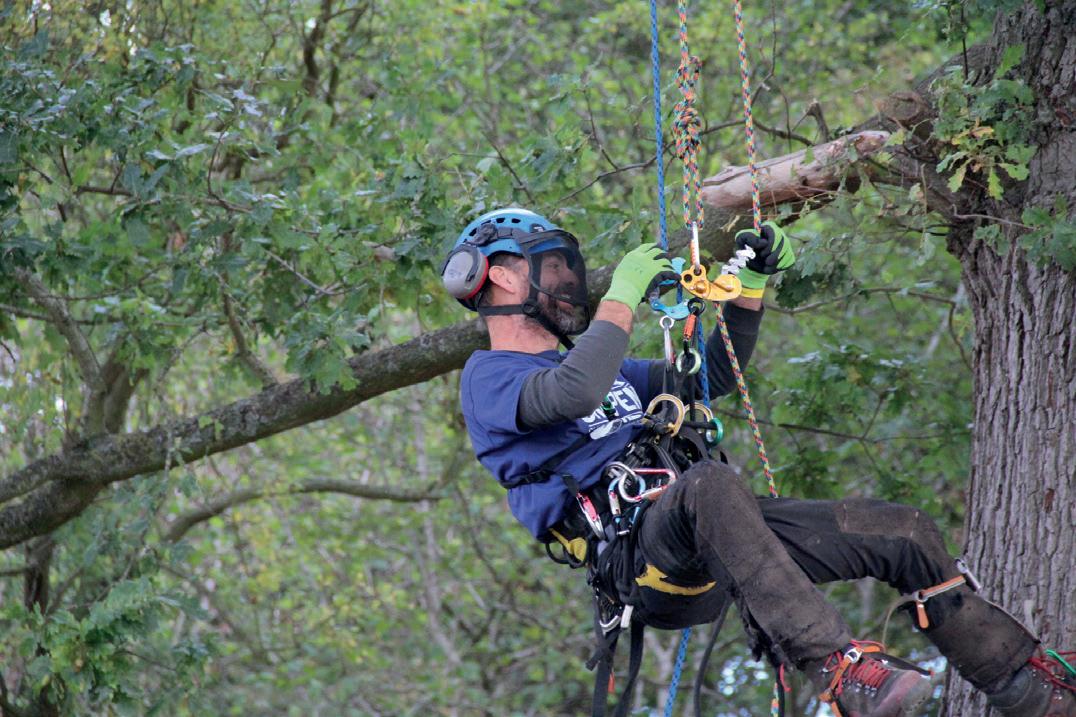














Tubex Nature is the first biodegradable tree shelter to combine externally tested soil biodegradability with scale of manufacture and proven performance.



The latest addition to the Tubex range is designed to perform, providing the same high levels of browsing protection and growth facilitation expected from the standard Tubex range. Ideal for areas with dense woodland or limited access, Tubex Nature Biodegradable Shelter is the most responsible alternative where collection and recycling is not practical.
Manufactured using a bio-based blend, including sugarcane, corn and starch, Tubex Nature Biodegradable Shelter can be left to biodegrade in situ and will, over time, start to degrade and breakdown into water and CO2 through a microbiological process.
• Biodegradable in situ: Externally tested against ISO 17556 to demonstrate soil biodegradability
• Bio-based: With materials derived from sugarcane, corn and starch
• Non-toxic: Externally tested against OECD 207 and 208
• Proven performance: Tested to perform with expected 5-year service life with a robust twin-walled construction, while providing excellent light transmission to facilitate growth
• Easy installation: Includes pre-fitted re-release ties
SCAN ME to learn more about Tubex Nature
The curse “may you live in interesting times” comes to mind yet again. As I write, the pound is plumbing depths not seen since the 1980s, taxes are being cut but interest rates are climbing, energy prices have been capped (temporarily for businesses), and war in Ukraine continues.
What will it all add up to? Well, here’s my best attempt at a (VERY!) early analysis.
find more ‘business-friendly’ ways to achieve net zero, incentivise investment, etc.
STUART GOODALL CHIEF EXECUTIVE, CONFORI expect the ‘new’ UK Government will focus on economic growth with a zeal perhaps greater than anything we’ve seen before. Growth isn’t something you can turn off and on like a switch and there has to be an election in just over two years’ time. So, there’s no time to lose.
The machinery of government is the ultimate example of a super-tanker that takes time to turn, especially when it’s something as over-arching as delivering a step-change in the economy – and the headwinds are strong, even for a super tanker!
We can expect that UK departments will be told to do what they can to deliver growth – deregulate, challenge current orthodoxies like that on restricting migration,
Confor is a membership organisation that promotes sustainable forestry and wood-using businesses. Confor members receive Forestry and Timber News for free as part of their membership. For more information on membership, visit www.confor.org.uk/join-us
Past issues and articles can be accessed online at www.confor.org.uk/news/ftn-magazine
Non-member subscriptions: £71.50/(£77 overseas) Contact FTN@confor.org.uk
Forestry and Timber News is published by Countrywide Publications on behalf of Confor. For advertising, contact Julia Curtis 01502 725857 julia.curtis@micropress.co.uk Printed by Micropress Printers Ltd
Stuart Goodall Chief Executive





Andy Leitch
Chief Executive
In the rural sector, we have a strong story to tell about modern productive forestry and timber to unlock growth, while still delivering greater biodiversity and tackling climate change. That said, it’s already clear Defra ministers are likely to champion greater food security. This will be challenging for further tree planting on higher quality land in particular.
Meanwhile, we’re seeing NGOs gearing up for a big fight on the threat they see to ‘nature’ from a dash for growth, and Labour (leading in the polls) is unrolling a twin track message of fairness and being green.
At Confor, our aim is to get in early so that we can present our case and avoid being buffeted too much by the inevitable arguments and shifting alliances around us. The fact we can deliver both economic growth and environmental benefit stands us, as always, in good stead.
So, while it’s not clear what impact this will have on the sector outside England, for those of us operating there my advice is –buckle-up! This could be quite a ride…
Maria Bellissimo Policy Officer




07884
maria@confor.org.uk
Anthony Geddes National manager for Wales
07494 079305
anthony@confor.org.uk
Eliza
Eleanor O’Neill
Caroline
manager for England
Richard Hunter
Manager
April Armstrong National Manager for Scotland
07780
april.armstrong@confor.org.uk
Confor head office and editorial office 59 George Street, Edinburgh EH2 2JG www.confor.org.uk
info@confor.org.uk
Follow @forestsandwood on Twitter for the latest Confor news and updates


The 2020 25-year softwood availability forecast, originally due for publication in December 2020, was finally published on 29 July 2022, over 18 months later than planned. Of course, the Covid pandemic didn’t help the Forest Research team meet the challenging deadline.
So now that we have it, what can we read into the outputs of the report?
A key point to remember is that this is a forecast of softwood availability and does not necessarily reflect how much volume will come to the market, and when. This is becoming a greater influencing factor as the percentage of the forecast timber is from the private sector.

Compared to previous versions, there are differences in how this forecast was de
rived. Yield models have been updated and they are predicting greater production across the board, with Sitka spruce models now allowing for up to Yield Class (YC) 40, whereas previous forecasts capped Sitka YC at 24.
Instead of running the forecast with yield models at maximum mean annual increment, it is based this time, at the behest of the private sector working group, on assumed felling at a maximum DBH (diameter at breast height) of 30cm for spruce and 25cm for other species. This is to reflect current management practices and market demands.
Adopting this scenario, alongside delays in felling over the last five years, has contributed to an increase in overdue stands, now predicted to be nearly 100 million m3obs. The forecast assumes that 75% of this will be felled over the 25-year period.
The UK stocked area of standing conifers is reported to have fallen from 1.384 million hectares in 2016 to 1.3 million hectares, most likely because of restructuring through the implementation of the UK Forestry Standard in restock plans.
It is assumed that at least half of the reduced area is now planted with broadleaves. However, this remains to be seen and may warrant further investigation thorough analysis of restocking species and area breakdown to get a more accurate picture.
On a positive note, the forecast estimates that there is more standing volume than there was five years ago, at 409 million
m3, up from 376 million m3 in 2016. This is mainly a result of predicted higher yields from improved spruce.
It should be noted that this volume is forecast to reduce to 348 million m3 by 2042-46 because of the age class structure of UK forests predicted at this time.
So how does this impact on the forecast?
• The forecast of potential softwood availability for the UK forest estate is an average of 16.5 million m3 of softwood timber per annum over the 25-year period:
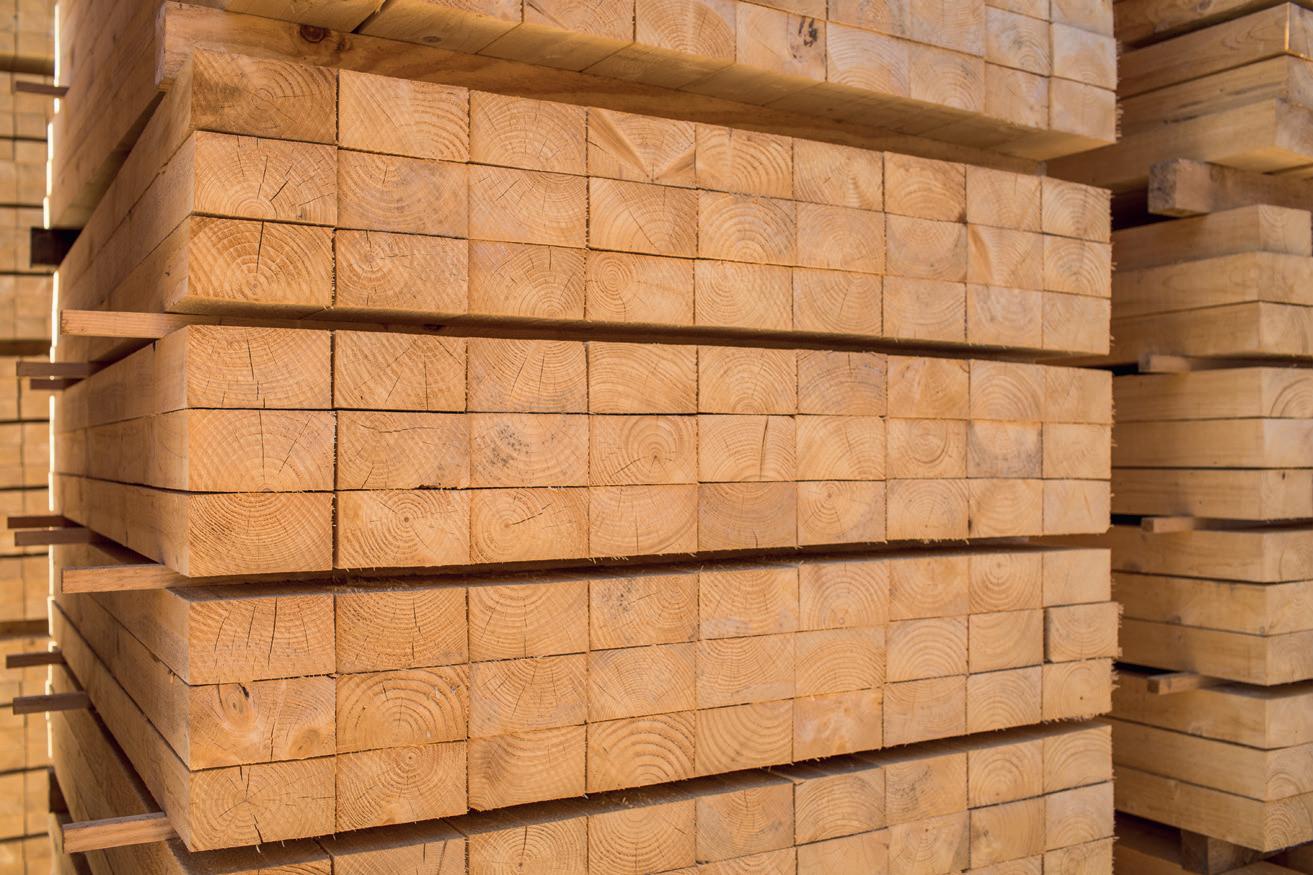


• Scotland: 10.7 million m3obs
• England: 3.5 million m3obs
• Wales: 1.7 million m3obs
• Northern Ireland: 0.6 million m3obs
It should be noted that approximately 12.4 million m3obs of softwood was harvested in 2020.
• The range of softwood availability over Figure 1: Summary of the 25-year forecast of softwood timber availability 2022 for the public forest estate and private sector estate in the UK (25-year forecast of softwood timber availability, Forest Research, 2022).
continued on
“THE UK STOCKED AREA OF STANDING CONIFERS IS REPORTED TO HAVE FALLEN FROM 1.384 MILLION HECTARES IN 2016 TO 1.3 MILLION HECTARES” 2022-26 2027-31
the 25-year period is from 15.1 million m3 per annum in 2022–2026, rising to 18.2 million m3 per annum in 2037–2041, before reducing to 15.5 million m3 per annum in 2042–2046. Whilst the profile is very similar to the 2016 forecast, the drop in availability isn’t now forecast to happen until the 2040s.
• The profiles for the public forest estate and private sector estate are different. Over the forecast period, the public forest estate shows an overall reduction in forecast availability while the private sector estate shows an overall increase. Private sector softwood availability is forecast to increase for the first 20 years of the forecast period followed by a decline from 2042-2046, with annual availability in the last 5 years (2042–2046) returning to a level similar to the 2027–2031 period.
• The GB public forest estate is projected to generate an average of 5.1 million m3 of softwood timber per annum for the next 25 years if existing forest plans are followed and production/marketing is not constrained. In the first five-year period (2022–2026) 6.1 million m3 per annum would be potentially available and this will reduce to an average of 4.1 million m3 per annum in the final five-year period (2042–2046).
It has been intimated that Scotland will offer less to the market than forecast, which is disappointing news for processors and could negatively impact on Scottish Government’s ambitions to store more carbon in construction through wood products.
• The potential availability of softwood timber from the private sector estate for the UK is forecast to average 10.8 million m3 per annum for the next 25 years. The forecast for England is an average of 2.4 million m3 per annum; for Scotland 7.6 million m3 per annum; for Wales 0.8 million m3 per annum; and for Northern Ireland 0.035 million m3 per annum.
Availability ranges from 8.5 million m3 per annum in the first five-year period, with maximum annual availability of 13.0 million m3 per annum occurring in the period 2037–2041.
• The private sector forecast represents potential availability of softwood timber under the assumption of a management scenario of felling at a specified target diameter where viable. The actual levels, and timing, of timber that will be brought to the market will vary from the forecast as the decision to harvest is influenced by other factors such as market conditions and owner objectives.
As reported above, the new forecast clearly illustrates increased availability for the next 20 years, which is positive news for growers and processors alike. But of
Average annual availability per period (thousands of m 3 overbark standing
25,000 20,000 15,000 10,000 5,000
0
2017-21 2022-26 2027-31 2032-36 2037-41 2042-46
Total 2016 Private Sector 2016 FC/NRW/FS 2016
Total 2020 Private Sector 2020 FC/NRW/FS 2020
Figure 2: Comparison of 2016 and 2022 softwood timber availability forecasts (I. Stewart, 2022)
course, as we have known for some time, there will be a significant dip in availability after that.
How far down that dip goes and for how long is uncertain, and that lack of certainty will impact on the confidence of the wood processing sector for future investment and growth: that is why we now need a 50year softwood availability forecast as soon as possible.
It is not just processors that need this clarity, but policy makers. At present there are net zero targets not only to increase tree planting, but to increase the amount of wood used in construction and now an increased government focus on productivity and growth.
If the long-term 50-year softwood forecast shows availability is much less than it is today, urgent action will be required to ensure these important targets are achieved and maintained. Especially if we continue to fail to meet planting targets, minimise the amount of productive softwood planted, and arbitrarily reduce the percentage of spruce planted on suitable soils.
This is against a backdrop where it is recognised that global demand for wood is forecast to triple in the next 25 years. The UK already imports 80% of the woodbased-products it consumes in a financial climate where the pound has touched an all-time low against the dollar.
There are also potential new (to the UK) green industries looking to wood as feedstock, such as wood fibre insulation and biorefining, all potentially adding economic value to the sector and the economy, as well as further climate change mitigation.
Confor has commissioned Guy Watt of John Clegg Consulting to undertake an update of the wood availability and
demand report, which accounts for the future ambitions, and associated demand, of the wood processing sector. The purpose of the report will be to provide a more accurate picture of wood availability and demand at regional, as well as national level over the next 25 years.
It is anticipated that the final report will be published early in the new year.
Further wood fibre availability forecasts are in the pipeline (the 50-year hardwood availability and 50-year softwood availability) but the publication dates have yet to be agreed.
As part of our support for members we arranged with Forest Research (FR) to hold a seminar on 28 September, where the forecast and its outputs were discussed and explained in more detail. There was also a session on the new spruce yield models. A recording is available on the Confor website.
Forest Research have set-up a small Production Forecast (Private Sector) Review Group which consists of private/public sector representatives. The purpose of the Group is to help Forest Research identify opportunities to better plan and execute future forecasts. The findings of this group will be shared more widely in due course.
Bontddu, Barmouth, Gwynedd 474.14 Acres / 191.88 Ha
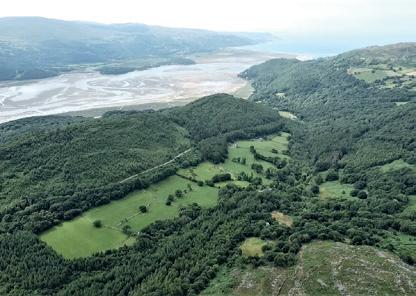
Fast growing forestry asset in rural Wales combing Snowdonia National Park location with outstanding commercial forest. Sporting included. Guide price: £3,750,000

REEDSHAW MOSS Keighley Road, Cowling, North Yorkshire 134.94 Acres / 54.61 Ha
Fully mature spruce forest planted in the 1970s on good conifer ground with superb vehicular access. Located next to Laneshaw Reservoir. Guide price: £1,300,000

Sarn, Montgomery, Powys 73.18 Acres / 29.61 Ha
A compact, commercial forest of newlyplanted spruce and Douglas fir as well as extensive stands of mid rotation spruce and pine. Sporting included over part.





Offers over: £375,000


Ciliau Aeron, Aberaeron, Ceredigion 45.79 Acres / 18.53 Ha
A restored ancient woodland on a valley side only two miles from the sea. This tranquil leasehold woodland offers amenity benefits and timber harvesting.

Guide price: £160,000
CEFN BRAN WOOD
Cefn Bran, Llanfyllin, Powys 25.89 Acres / 10.48 Ha

A modest but nonetheless impressive economically-viable woodland. Second rotation mixed conifer dominated by Sitka spruce. Sporting included. Offers over: £180,000

Dinas Mawddwy, Gwynedd 29.74 Acres / 12.04 Ha
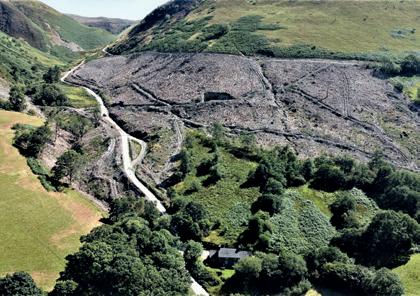
A high quality replanting site with species mix of own choosing. The site is clear, well roaded and highly fertile.
Sporting rights included. Offers over: £93,000
THE KINGTHORPE WOODLANDS Kingthorpe, Pickering, North Yorkshire In all - 243.5 Acres / 98.5 Ha




A collection of four woodlands with a wide range of species and ages ranging from mature and maturing commercial crops and mixed broadleaves. Guide prices: £25,000 - £975,000
TWO POND COPPICE & THE BELT Alwalton, near Peterborough, Cambridgeshire 15.50 Acres / 6.27 Ha
An attractive, principally mid-rotation oak woodland with two ponds. Sporting included. Guide price: £140,000

MENITH WOOD Menithwood, Worcestershire 7.25 Acres / 2.93 Ha
Charming youthful broadleaved woodland with ancient belongings close to the Wyre Forest Nature Reserve.
Sporting included.
Offers over: £94,000
CLIFTON HEATH WOODLAND Clifton Hampden, near Abingdon, Oxon 91.21 Acres / 36.91 Ha


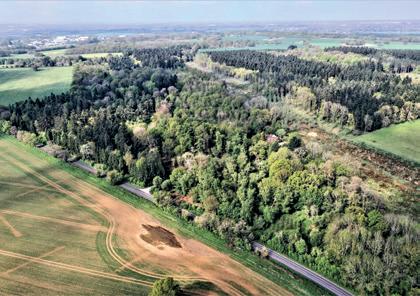
An interesting opportunity to acquire a high quality managed forest in a rural location within easy reach of the city of Oxford. Sporting included. Offers over: £990,000

This update was supposed to be all about the new Government and the incredibly supportive new Forestry Minister that, in normal circumstances, the new administration would have appointed by now.
In a very sad turn of events, all Government and Parliamentary business was suspended on the evening of Thursday 8 September, when Her Majesty the Queen passed away. The days since then have been a time of reflection and mourning as we all come to terms with the loss of such a beloved monarch and outstanding example of service and dedication.
Given Her Majesty’s love for nature and trees (she planted more than 1,500 trees during her reign), I cannot think of a better way to pay our respect to her and welcome our new King Charles III than promoting the forestry and timber sector with even more determination and ambition for our future.
After a two-month long campaign, Liz Truss was announced as the new leader
of the Conservative Party on Monday 5 September, after being chosen by 57.4% of the Conservative Party membership. The campaign itself was quite brutal, marked by many personal attacks from both camps that sparked concerns for the unity and governability of the Conservative Party in Parliament after the contest.
Although Ms Truss was considered the favourite from the start, her opponent, former Chancellor Rishi Sunak, ended up with a higher share of the vote than anyone expected.
In her first speech as Prime Minister, Ms Truss set out her plan for the United Kingdom: economic growth, energy to power the country, and an NHS fit for purpose, alongside the promise to continue supporting Ukraine in its effort to repel the Russian invasion. The renewed focus on growth and delivery are very welcome.

The Confor team sees in this the opportunity to reset the engagement with the UK Government and Parliament and obtain greater policy support for our sector, something which the previous administration has failed to do.
Of course, the new DEFRA team will be a determining factor in this. Mirroring the Prime Minister’s focus on growth, in his first message in his new role the new Secretary of State, Ranil Jayawardena, MP for NorthEast Hampshire, stated growing the rural economy as one of his key priorities. We plan to make the new Secretary of State aware of the great contribution to the rural economy and decarbonisation that our sector already makes and – most importantly – of the even greater potential for growth and job creation that can be unlocked with supportive policies from his department.
It’s impossible to avoid the so-called elephant in the room: the Forestry Minister role will have a huge impact on our industry, how much we can contribute to growth and net zero, and the opportunities for further development that we will grasp or miss over the next few years.
As was highlighted in the last issue of Forestry & Timber News, we feel that the outgoing Forestry Minister has been more focused on a personal agenda than on delivering government commitments or achieving net zero.
We look forward to working with a new representative to deliver the tree planting targets, address the barriers that their pre decessor exacerbated, and unlock invest ment in planting and wood production to help the industry make the most of the op portunities of decarbonisation.
This new appointment, alongside a re
“THE CONFOR TEAM SEES IN THIS THE OPPORTUNITY TO RESET THE ENGAGEMENT WITH THE UK GOVERNMENT AND PARLIAMENT AND OBTAIN GREATER POLICY SUPPORT FOR OUR SECTOR.” continued on p13
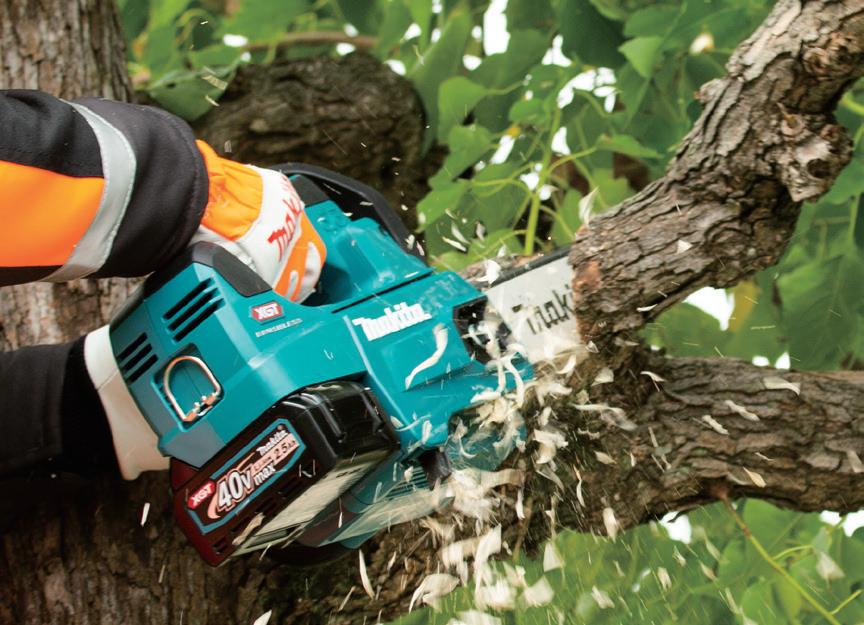

Preservative pressure treatment provides wood with added durability. However, it’s a mistake to assume that all pressure treated wood is the same – treatment levels should be tailored to the desired end use (Use Classes).
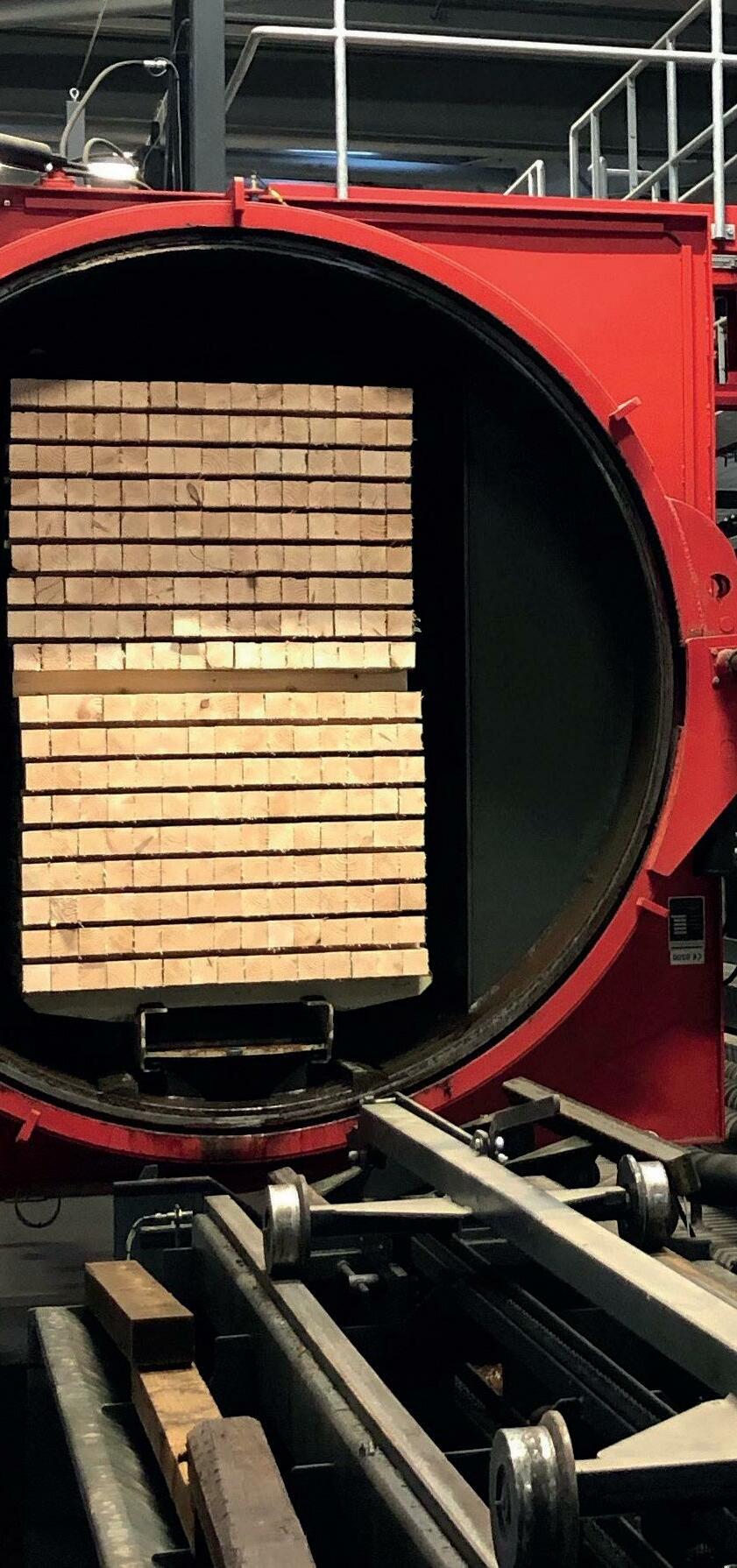
When ground contact timber is treated correctly to Use Class 4 standards, it is fit for purpose – evidence from WPA field trials supports this.
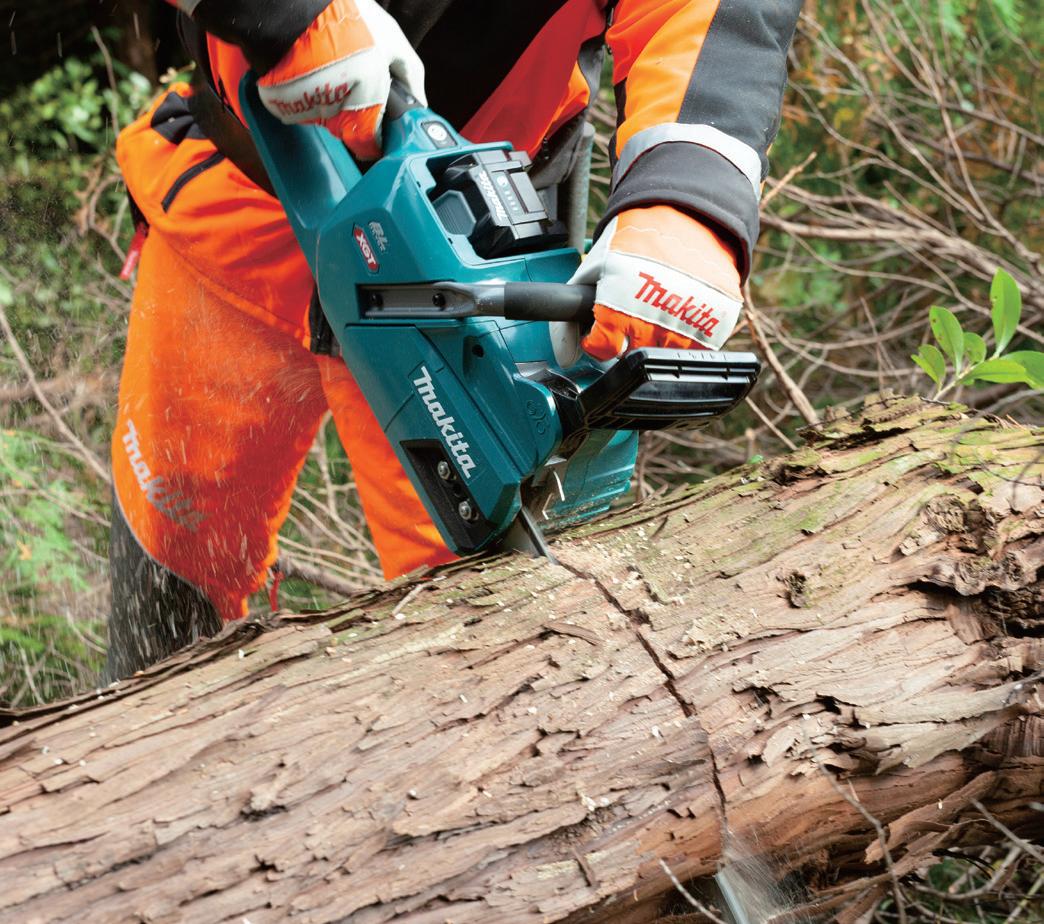
Several timber trade bodies are working together to help ensure that quality standards are assured across the timber




chain.



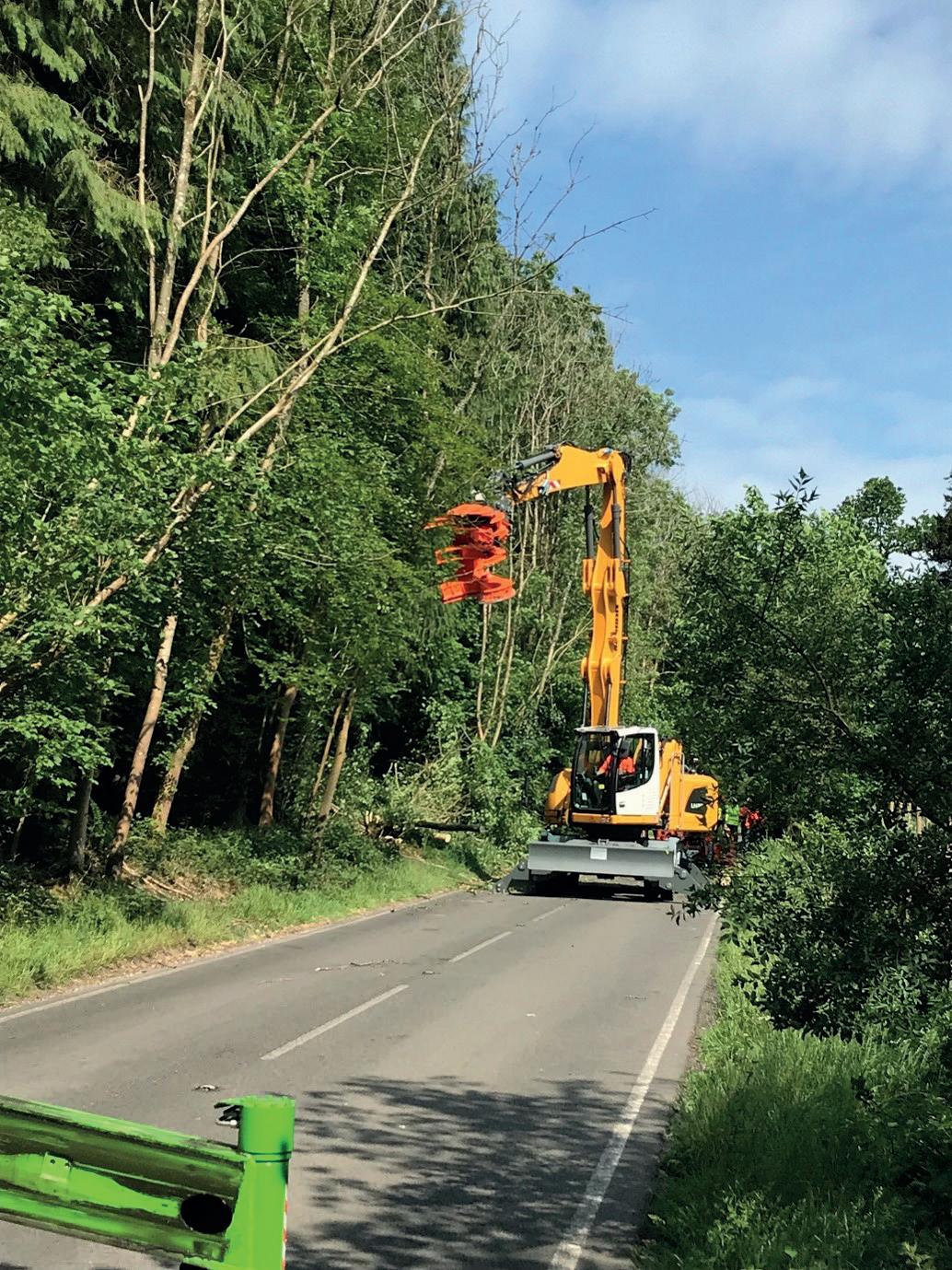


newed focus on sustainable timber sup ply for the UK, brought by the upcoming COP27 and an ongoing inquiry on the topic led by the Environmental Audit Com mittee, will hopefully result in new efforts to plant more trees - especially for timber production.

Our efforts to promote our industry and represent the needs of our Members are not limited to DEFRA. We are aware of the concerns that many members are ex periencing caused by the energy crisis and we will be working with the BEIS ministe rial team to press for future support for the industry.
In particular, the appointment of a Minister for Climate, Graham Stuart MP, within BEIS is a very good opportunity to promote the sector’s credentials for sustainable green growth and jobs.
Just in time for this issue, the Prime Minister and the Business Secretary, Jacob Rees-Mogg, announced the details of a programme of interventions aimed at freezing energy prices for businesses. From 1 October 2022 to 31 March 2023 (when it will be subject to review), a Governmentbacked Supported Wholesale Price will be in place for businesses on fixed price contracts which should be £211 per MWh for electricity and £75 per MWh for gas.
For businesses on variable tariffs or flexible purchase contracts, there will be a Maximum Discount of around £405 per MWh for electricity and £115 per MWh for gas. Support to reduce energy bills will also be made available for all business that are off-grid or use other fuels, but we are still awaiting the details.
It will be very useful for us to receive your comments and first-hand experience of what these measures mean for your business, and what actions you are taking to adapt to the current situation in the en ergy markets. Hearing from you will help us build a strong case to ask for further or
On the same day the new Prime Minister started forming her Government, Scotland’s First Minister, Nicola Sturgeon, announced the new Programme for Government. In it, she recommitted her Government to meet the net zero target by 2045 and identifying new opportunities to grow the economy in a sustainable way.
She also mentioned the intention to “enhance the Forestry Grant Scheme to deliver better community engagement, improved biodiversity and increased val ue for money”. In anticipation of this, our engagement work in Scotland has fo cused on these same themes, so we plan to continue working with our Members, MSPs, and the Government to support improved community engagement and to highlight the biodiversity and eco nomic benefits we deliver.
Over the summer, we have also been working on the Confor response to the
Land Reform Bill consultation. We would like to thank all the Members who have shared their expertise and views with us to help us compile a comprehensive re sponse. Land Reform is a priority for the SNP-Green Party coalition, so we expect this issue to receive a lot of attention over the course of this Parliament.
This latest bill, to be introduced to Parliament in late 2023, will be the third piece of legislation since 1999 that aims to give communities more power in determining land use in their areas. The proposals set out in the document so far are not very detailed, but it is clear that the potential impact on forestry is very significant.
We plan to increase our engagement in Holyrood around this issue to ensure that the new Bill will strike the right balance between empowering communities and creating economic opportunities where forestry is involved.

A renewed focus on sustainable timber supply in the UK will hopefully result in new efforts to plant more trees.continued
Confor is set to host its first major UK policy conference since 2018 in London this December.

Join representatives from Confor and the sector to examine the increasing demand for wood, globally and in the UK. The all-day event will feature sessions identifying how to grow domestic supply, unlocking investment and job creation, and helping achieve net zero.
Speakers include Lord Deben, Chair of the Climate Change Committee, Richard Stanford, CEO of the Forestry Commission, and Mike Childs of Friends of the Earth.
The conference, kindly sponsored by Scottish Wood lands Ltd and Tilhill, will also highlight the work of Confor and its Members in promoting the sector in areas like commu nity engagement and attract ing new talent to the industry.
Stuart Goodall, Confor Chief Executive, said: “The new Prime Minister has signalled her de termination to drive growth in the economy while still achiev ing net zero, and our sector is one of the best-placed to help deliver that ambition.

“However, that will mean change and this conference is well-timed to inform the new administration on what is re quired to unlock growth in for estry and wood manufactur
ing. I call on Members to join the discussion and have your say.”
Ralland Browne, Managing Director of Scottish Woodlands Ltd, said: “Scottish Woodlands Ltd is very happy to sponsor this significant policy confer ence, which will examine the current challenges facing our industry, but more importantly, look at how we rise to those challenges and work together to overcome them.
“Part of that approach must be changing public attitudes towards forestry and wood processing – and this has been a key focus for Scottish Wood lands for some time. I very much look forward to contrib uting to the wide-ranging con ference discussions.”
Gavin Adkins, Managing Di rector of Tilhill, said: “Tilhill has always been at the forefront of discussions about the future of our industry, and we are de lighted to sponsor this impor tant event.
“Securing future timber supply in the UK is vital, and it’s so important that the pub lic and private sectors work together to ensure that we continue to plant the trees and grow the wood that future generations will need.”
hope those who attended the APF had a good time, it was wonderful to meet a lot of you there. After speak ing via phone and email for nearly a year, it was great to put names to faces!
Members should have received renewals invoices for 2022/23 by now; if you haven’t or if you have any queries about how to pay, please get in touch and I will be happy to assist you. The new subscription year starts on 1 October 2022.
I am so pleased to an nounce that our Membership Directory is now live! It’s sim ple to register your details if you haven’t already - all you need to do is log into the Members Area of our web site using your Membership Number.
The Membership Direc tory is a free promotion tool for our members so please take advantage of it. We regularly signpost queries to the directory, so you are missing out on potential business opportunities if you aren’t part of it. If you need any assistance with how to upload your details, please let me know.
I am also proud to an nounce that we have a new partnership with Dell that entitles our Members to a special Confor discount on technology products and accessories, access to tech advice, and other benefits. Find discount codes for up to 20% off in the Members Area and simply pop them in at checkout on the Dell UK website.
Our Annual Report 2022 is also available to view and
download from the Mem bers Area. This is a great way of seeing what Confor has done for you over the last year. If you can’t locate a copy of the report, please let me know. (See a summary of the Annual Report on p16.)
We are really keen to get Member feedback as we come into our new sub scription year. To share your thoughts about Confor, scan the QR code below or visit https://bit.ly/3eUBkJv. It only takes two minutes to complete and your feedback is really important to us.

The Confor Dinner 2023 is approaching from across the horizon and tickets will be released soon! Keep the 28 February 2023 free for a glamorous, forestry filled evening.
And finally, welcome to our newest members: England: Joshua Herron, Her ron’s Tree Solutions; Kieran Herron, Forestry Profession al; Tom Gillett, Treeworthy Services; Rod Richardson, Emmaus Cornwall (Commu nity Tree Nursery).
Scotland: Skye Campbell Bancroft, Scottish School of Forestry (Student); Dale Reed, AHB Forestry Ltd.
Contact Eliza on 07918 880285 or email eliza@confor.org.uk

In the end, it’s all about how it feels. The unbeatable feeling of cutting effortlessly through wood with a truly reliable and robust bar that you can trust. Husqvarna’s range of chainsaw bars cater to your every need, matching your chainsaw’s performance just as much as it matches your own. Learn more at husqvarna.com or scan the QR code.


 HUSQVARNA
HUSQVARNA
Confor is working for you all year round. These are just a few high lights from 2022, illustrating the real value of your membership.

Our Changing Attitudes campaign this year explains why we need to produce more wood, contrasting rising UK and global de mand with forecast declining availability. With global supply falling behind demand, Government is challenged to act so the UK has the timber it needs to decarbonise construction and achieve net zero.
So far, we’ve secured coverage in na tional newspapers, the BBC, Westminster media, and Times Radio as well as con struction and architects journals. The cam paign complements our lobbying, which has seen us work with Friends of the Earth on their report that calls for greater do mestic wood production.
We are working to establish what spe cific planting is required to secure future supply, including utilising more of the ex isting woodland resource and the potential for greater on-site fibre recovery.
We are working with the English and Welsh governments to develop industry leader ship groups and strategies to grow the sector. This builds on the existing group in
Scotland and, as one of the few cross-bor der organisations in the UK, we are com bining efforts already to tackle the issue of bringing new recruits into the sector.
In addition to running taster sessions for harvesting and timber wagons, we’re developing a portal with the Armed Forces to match industry vacancies with people preparing to leave the service.
With Defra, we’re developing a govern ment-wide roadmap to increase the use of wood in construction, and we continue to provide advice on a proposed “Borderlands” Forestry Innova tion Centre.

We’ve seen stakeholder opposi tion to planting flare up in a number of places in England, Wales and Scotland. This has ‘spooked’ ministers and added to existing delays and obsta cles.
Recognising the problem, and that it can also affect other operations like harvesting and timber transport, Confor is developing a resource hub for Members. This will bring togeth er existing and new visual assets for engagement with the public
and relevant parties.
We are also working with a consultant to develop training for people in the sector who deal directly with stakeholders.
Achieving net zero by 2050 (2045 in Scot land) will have an enormous impact on industries, including forestry and wood processing. It is expected that industries will produce sector net zero roadmaps and that, done properly, these roadmaps can provide the means for industry to chart the best path forward.

Confor has commissioned a con sultant to produce a carbon analy sis of the UK supply chain and the Board has agreed that we will now work with Members (and part ners in the forestry agencies) to develop a roadmap. This is ex pected to be published in Spring 2023. This will be presented to governments as a means to tar get measures to reduce carbon emissions.
We worked closely with Members and HMRC to ensure that supplies
of red diesel were not disrupted to forestry businesses in April when the new tax regu lations were introduced.
As well as maintaining our regional com mittees, we have recommenced a number of technical support groups, including re gional processors groups, a harvesting and contracting committee, safety, technical and compliance groups, and the environ ment group.
We continue to provide executive sup port to the Scottish Industry Leadership Group (ILG) and have set-up an ILG in Eng land that is actively developing a sector strategy for productive forestry and woodbased industries in England.


In addition, we are actively speaking to Welsh government about leading on a similar strategy for Wales.
Through funding from Scottish Govern ment and in-kind from industry, we devel oped and delivered a series of events offer ing potential new entrants an introduction to forest machine operation and driving in timber haulage.
We are also currently leading the devel opment of a public/private sector national technical training skills hub.
MORE INFORMATION The full ‘Annual Re port 2022: What does Confor do for me?’ was shared with Members along with sub scription invoices for 2022/23. A digital copy may be requested by emailing FTN@ confor.org.uk.

Confor Chair Lord Ian Duncan led the 2022 Annual General Meet ing, held in the Confor tent at the APF exhibition on 22 September.

It was confirmed that the required quorum of at least 20 Members were ei ther in attendance or had allocated their vote to a proxy. Votes were counted by a show of hands.
There was first a small correction to the minutes of the previous AGM, not ing that a Member had been speaking on their own behalf, rather than as a representative of their organisation at the time. This was acknowledged and no further objections or comments were put forward.
Kirstin Donaldson, Head of Finance and Company Secretary, then talked through the audit report and accounts for the year ending 31 December 2021. On behalf of the Board, Lord Duncan proposed that the audited accounts sub mitted to the meeting and the reports of the Directors and Auditors thereon be adopted. This resolution was approved.
Chief Executive Stuart Goodall, act ing on behalf of the directors in consul tation with the Advisory Board, put the reappointment of Lord Duncan as Chair
for a further two years to vote. This was also approved by Members.
Finally, Lord Duncan proposed that Greaves West & Ayre, Chartered Ac countants, be appointed as auditors and this motion was also carried.
The AGM was followed by a lunch, kindly sponsored by John Clegg & Co, during which Stuart and Deputy Chief Executive Andy Leitch updated Mem bers on Confor’s activities and achieve ments throughout the year prior.
We would like to thank all those who attended and contributed.
After four years away, the Confor Woodland Show will be taking place at a new location on 21-22 September 2023.
We are excited to be taking over Bath and West Showground with an exhibition of all things forestry and wood and hope the move to a new venue will bring new opportunities and the chance to grow the show’s offering for our exhibitors and Members.
In 2019, 1,550 visitors attended the Confor Woodland Show at Longleat, tak ing in demos and displays from 100 exhib itors, as well as enjoying a hive of activity in the Confor seminar tent.
The trade show provides a platform for industry professionals to network, meet
ready been a wonderful experience this year and the chance to meet so many of our Members and industry representa tives at APF 2022 really drove home the value of those experiences.
existing and potential customers, and see what others in the sector have to offer.
Confor Chief Executive Stuart Goodall said: “We are delighted to be bringing the Confor Woodland Show back to the southwest in 2023.
“The return to in-person events has al
“I look forward to an equally successful Confor Woodland Show 2023.”

Booking for exhibitor places will be available soon so keep an eye on the Con for website for early bird prices – every thing is available on a first come, first served basis! If you were an exhibitor at APF 2022, you are also entitled to an ad ditional 5% discount.
Various tiers of sponsorship for the show and certain events therein are also available. These will also be announced in due course.
Confor is excited to support young learners across Scotland with the ‘Climate Smarter’ project for another year, encouraging interests in science and forestry.
Confor has again committed to be a sponsor of the ‘Climate Smarter’ initiative, delivered through SCDI’s Young Engineers and Science Clubs (YESC).
Climate Smarter is an exciting project designed to develop the STEM and digital skills of second and third level pupils (Pri mary 6/7 and Secondary 1/2) in Scotland. Young learners are encouraged to think creatively to come up with solutions to the biggest global problems that they face now, and those that will impact them in the fu ture.
YESC provides schools with the resourc es and training to deliver experiments and activities that will take them on a journey to investigate how we can tackle the climate emergency. This includes wood samples supplied by Confor with the help of Dave Mills at Boat of Garten sawmill, and Logie Estate.
The programme culminates in the pupils designing and building models of their fu ture eco-school, incorporating all their re search into sustainable building materials, energy efficiency, smart controls, energy generation and responsible water use.
They then showcase these models for judges and other school teams at Cel ebration of STEM events throughout the country.
Confor Communications Manager El eanor O’Neill went along to one of these events at the Scottish School of Forestry earlier this year. She said: “It was fantas tic to attend the event and see what the primary and secondary pupils have been working on.
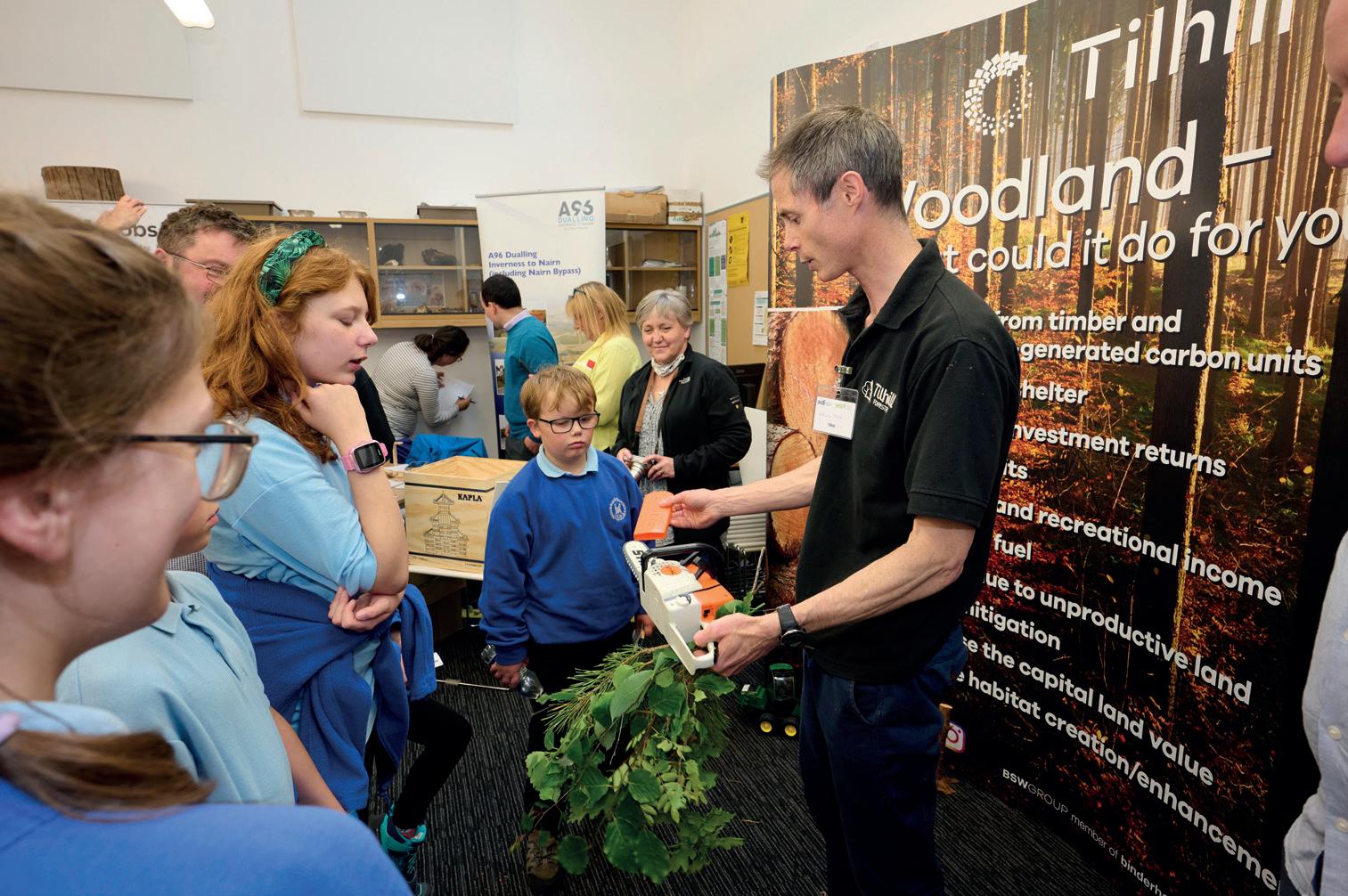
“The attention to real-world problems and creativity in finding solutions was very impressive. All the participating schools
should be very proud, and we look forward to seeing more from them in the future.”
Over 1,500 schools are currently a part of the YESC network, engaged in a variety of in-classroom and extracurricular projects to build knowledge and skills.
If you would like to find out more about getting involved with YESC through giving talks at schools, running activities at events, or providing resources for learning, get in touch with Eleanor O’Neill (eleanor.oneill@ confor.org.uk).
The MSA 220 TC-O is STIHL’s most powerful cordless arborist chainsaw to date. It’s the first STIHL chainsaw that has an LED display and integrated oil sensor, which provides key information during operation. With equivalent cutting performance to the petrol MS 201 TC-M and longservice life, arborist professionals can take on the tough tree maintenance and removal jobs.

The new ADVANCE ProCOM headset and ear defenders on the X-CLIMB helmet allow you to communicate with workers on the ground seamlessly, with simple networking over vast distances for up to 16 people, plus much more.

SMART, EFFICIENT, COMFORTABLE COMMUNICATION: STIHL ADVANCE PROCOM.
OUT MORE AT STIHL.CO.UK







This year has seen a wider range of Educa tion Fund award applications than previ ous years. These included the more tradi tional chainsaw, tree climbing and safe use of pesticides courses; tertiary level Diplo ma, MSc and dissertation modules; as well as FSC® Forest management course and Project Management qualification.
The Education Fund is open to all Confor Members wishing to undertake technical and professional courses as well as educational trips, field courses and study tours. Applicants should not only outline the benefits to their career in for estry of undertaking the training or visit, but also how they can contribute to the wider development of the forestry sector.
A couple of recent award winners have shared their experiences.
SIMON WEBB undertook a Soil Asso ciation FSC® accredited Forest Manage ment Course to improve his knowledge on FSC certification processes, progressing his role as a lead auditor for a UK-based certification group.
The course started with 16-20 hours of e-Learning, undertaken prior to the in structor-led element, and introduced the basics of FSC forest management, the his tory of the Forest Stewardship Council and why the development of the 10 principles was necessary for ensuring sustainable forest management. This also included an assessment on Trademark use and imple mentation.
The instructor-led training was held online over the course of five days, with 10 other students from across the globe. Each of the 10 FSC Principles were covered in greater detail, with specific sessions on Group Scheme Certification, Audit Plan ning, and Stakeholder Involvement in Cer tification.
After each session, small breakout groups worked through scenarios to re inforce the content learnt and gain some practical experience through exercises such as analysing management planning documentation. We were also encouraged to apply any decisions to other relevant sections within the FSC standard and cross reference elements of the scenario that could apply to multiple International Ge neric Indicators.
Completing the training and receiving my FSC Forest Management Course cer tificate has meant that I am now in a better
LANGLEY LOGS, a Hertfordshirebased firewood specialist and merchant based in 100 acres of mixed pasture and woodland, recently applied to train their entire team on a two-day chainsaw maintenance and crosscutting course provided by Vale Training in Aylsebury.
Demand for product has grown yearon-year and was particularly apparent during lockdown as increased numbers of our customers were working at home and lighting their fires during the day as well as the evening. The kiln dried range was also popular with families entertain ing children with campfires and camping whilst they were unable to go to school.
To increase production to meet this demand, with the same machinery, work force, and time frame, we were looking at ways to improve our efficiency and productivity within yard operations. One way to do this was to increase and broaden our staff skillset.
position as a Group scheme auditor, offer ing dual certification, to ensure owners and managers alike are aware of the require ments to obtain certification for their for ests.
Certification helps to confirm the impor tance of sustainable forest management
With several staff relatively new to the business and others not fully trained to cord wood, we decided to train up the whole team to be able to use a chainsaw so, no matter who was available, the pro cessors would never be without wood, and we wouldn’t run out of our core sales product.
The grant application was very straightforward and the follow-up pro cess and communication with Confor very easy. Steve was an excellent tutor and we all felt we had learnt a lot, even those with previous chainsaw experi ence.
To have essential training funded was a great cost saving to a small operation like ours. But the overall financial impli cations are far wider reaching as more staff are now trained, able and safe to chainsaw. This has had a direct impact on our efficiency and productivity levels and therefore our profit margins.

for the long-term benefit of the forestry sector as a whole and the wider commu nity who rely on well-managed forests for a multitude of services.
More Information on how to apply is avail able at https://bit.ly/3Ue9fNy.
It was announced on 8 September 2022 that Queen Elizabeth II had passed away at the age of 96, after reigning as monarch of the United Kingdom for over 70 years.


As a long-standing and iconic figure in global leadership, her death was widely felt and reported by news services all over the world.
The forestry sector, too, was touched by her loss and Confor offered our con dolences to the Royal Family during the period of mourning and transition.
As noted by Lord Duncan, the Queen was responsible for planting an impres sive number of trees over her lifetime and many more were put in the ground in her name.
This is set to continue as the Queen’s Green Canopy (QGC) initiative, on the
wishes of patron King Charles III, has been extended to the end of March 2023 to give people the opportunity to plant trees in memoriam.
Created to celebrate Queen Elizabeth’s Platinum Jubilee, the nationwide tree planting project invited people across the UK to “Plant a tree for the Jubilee” honour the Queen’s reign with a contribution that will benefit future generations.
Over a million trees were put in the ground as part of the initiative during the
first official planting season from October 2021 to March 2022.
By inviting everyone to plant consider able numbers of new trees throughout the country, the QGC seeks to not only cre ate a living legacy to Her Late Majesty, but also to highlight the significant value of trees and woodlands in cleaning the air we breathe, slowing the impact of climate change, and providing important wildlife habitats.
In response to her passing, the Royal
Forestry Society (RFS) stated: “Her Maj esty’s love of trees was well known and most recently exemplified by the Queen’s Green Canopy which marked her Platinum Jubilee.
“Her Majesty followed a line of royal patronage of the RFS dating back to her great grandfather Edward VII. We are grateful that she was such an engaged patron over many years and are pleased to share these happy memories of her in volvement with the society.”
Lord Duncan of Springbank PhD FGS leads a tribute to Her late Majesty Queen Elizabeth II on behalf of Confor.Photo credit: www.shutterstock.com/Alessia Pierdomenico
Queen Elizabeth was a Patron of the RFS throughout her entire reign and at tended many events at Great Windsor Park and beyond. Notably, a number of RFS members were also kindly invited to visit the Buckingham Palace gardens and Sandringham Estate woodlands.

RFS President Sir James Scott, who has since stepped down, was among the 2,000 guests invited to Her Late Majesty’s funeral at Westminster Abbey and gave a reading.
Another standout contribution to for estry came in the form of The Queen’s Commonwealth Canopy, a conservation project aimed at raising awareness of the value of indigenous forests, and of pre serving them for future generations.
The project was launched in 2015 with an appeal to 53 Commonwealth nations to contribute areas of indigenous forest to be preserved in perpetuity to mark Her Majesty’s lifetime of service to the Com monwealth.
The Queen’s Green Planet, a 2018 ITV documentary that explored the ambition of the initiative, featured a conversation between Her Late Majesty and Sir David Attenborough, in which they discussed trees and nature while walking in the gar den at Buckingham Palace.
Poignantly, speaking about how cli mate change will have an impact on the trees they were viewing over the next 50 years, Queen Elizabeth II noted in good humour: “I won’t be here though.”
For most of us, Queen Elizabeth II is the only monarch we have ever known; a constant in a changing world.

Her first Prime Minister was born in 1874, her last more than a century later. Over seven decades, with quiet dedication she has served her people. The grief we feel today is the price we pay for love.
It was often through trees that the Queen marked events. In her lifetime, across the globe, she personally planted more than 1,500 trees. More than a million trees were planted to mark her Platinum Jubilee.
On behalf of Confor, I would like to offer sincere condolences to the King and the Royal Family at this most difficult of times.
We join the nation and so many around the world in mourning the passing of Queen Elizabeth II. She was an inspiration and represented so much that was good about the United Kingdom.
MAJESTY FOLLOWED A LINE OF ROYAL PATRONAGE OF THE RFS DATING BACK TO HER GREAT GRANDFATHER EDWARD VII.”Photo credit:




 Anthony Geddes, Confor National Manager for Wales reports
Anthony Geddes, Confor National Manager for Wales reports

The Royal Welsh Show 2022 was a highlight in the Confor Wales calen dar, showcasing the ability of the for estry sector to listen, reflect and engage on those serious issues, ranging from wood land creation and community engagement, to the new Sustainable Farming Scheme and Forestry Act reform. More to follow on those and the consultations later in the year.
The RWAS is also the stage for two great woodland-based competitions: the Wood land Awards and the Schools Woodlands Competition.
The Woodland Awards were, as always, well represented with 22 public and private woodlands across southeast Wales entered for the judges’ consideration. These awards cover a host of categories, acknowledg ing excellence in management of different age classes, planting species, management types and outcomes, including community or public access and farm woodland.
Special thanks must be given to our two judges, Chris Jones and Alan Hubuck, who generously gave up their time to visit all of these properties and use their years of professional experience to choose the prize winners. We would also like to thank John Clegg of Tustins for stepping into the breach to award the prizes to our success ful entrants at very short notice!
With a strong field of entrants, we must congratulate Bronwin & Abbey Forestry who swept the board with no fewer than 22 awards across seven different woodland properties. Of note are the Llanover and Llangoed estates owned by Ross Murray,
1st Cari Jones-Evans, Dolafon School
2nd Isla, Cefnllys School
3rd Kiki Jolie Johnson, Gynradd Saron School
1st Elgan Vernau, Gynradd Nefyn School
2nd Zakia Bella Johnson, Dyffryn Aman School
3rd Meleri Rees, Uwchradd Brynhyfryd School
which took eight awards, including Gold Medals in Conifer Woodlands categories for 11-30 years old and restocking, and the Best Entry in Woodland Classes 1, 2, 3 & 4.
A more than commendable showing and a testament to the quality of management and commitment to productive forestry.
Natural Resources Wales and Pryor and Rickett Silviculture also performed excel lently, taking seven and six awards respec tively. Gold medals were awarded to Pryor & Rickett for ‘Area managed using LISS’ and ‘Broadleaf woodland 11-40 years old’; and to NRW for ‘Community or Public Access Woodland’ and the Meirion Davies Memo
rial Perpetual Challenge Cup for the Best Community Woodland or Public Access Woodland in Stand Class H.
Both Tillhill and private farmer Glasnant Morgan were recognised for their manage ment of entries into the Conifer Woodland over 30 years old and Best Farm Woodland categories.


We will shortly publish the full schedule of results on the Confor website for those interested in viewing the winners and we encourage you to think about entering your properties in 2023. Details will be available on the RWAS website in the new year.
The second of what has become a RWAS institution is the Schools Photography com petition. The competition funded by the Welsh Government seeks to engage chil dren from primary and secondary schools across Wales with trees and forestry.

This year saw a theme of ‘People and Trees’ with a host of great prizes for the winners. With the focus on inclusion, the judges’ brief was simply “We want to see what trees mean to you!”. The entries could be a tree you pass on the way to school every day, a tree you have played on for ever, or a woodland or area that means a lot to you.
As the competition hadn’t been able to run during the pandemic, we saw some sig nificant rewards for the successful entrants, with winning schools being awarded top prizes of £1,200 and second and third be ing £800 and £500. Well worth the effort for those competing!
The competition is open to all schools in Wales and we encourage those reading this with school age children to get involved and share the competition with friends, family and other competitors! We would also like to extend our thanks to Ruth Rees for judg ing the photo competition from all those in the Confor Wales and RWAS teams.
Bronwin & Abbey winners (left) and NRW winners (right).As the sun came up on the morning of 22 September, APF exhibitors and staff were busy making final preparations to ensure the return of the sector’s big gest event in the UK was a success.
The weather (mostly) held up throughout the three-day exhibition and went a long way towards encouraging over 20,000 people through the gates. Everyone, from exhibitors and competitors to networkers and attendees, were clearly delighted to have this show in-person again.
Business was done, introductions were made, poles were climbed, and wood was carved. There was never a dull moment for the professionals or visitors who made their way to the Ragley Estate.
In the Confor tent Thursday saw a packed schedule of events for Members and guests to enjoy and engage with in the Confor marquee. Settled right beside the south gate, many early birds were tempted inside by the promise of a breakfast, kindly sponsored by Tustins, and a lively discussion.
Naomi Matthiessen, Director of the Government’s Nature for Climate Tree Programme at Defra, spoke to the gathered crowd about the work ongoing in her team and the direction of the forestry sector in the context of the new UK Government’s plans.
“We’ve now built a really strong team within Defra, working very closely with our Forestry Commission colleagues and a range of other delivery partners,” she said.
“Just over 18 months ago, we published our England Trees Action Plan, which sets out the government’s long-term vision for trees and forestry in England, including the ambition to treble tree planting rates in England by May 2024, and covering not just woodland creation, but also woodland management, trees outside of woodlands, the role of trees and forestry in our economy, and the huge importance they hold for all of us as individuals.”
Naomi, while answering questions
from the audience, did acknowledge that forestry as a sector has received a lack of political attention, particularly in England. However, she also highlighted that the new administration is a likely source of support.
“Our new Secretary of State, Ranil Jayawardena, has put economic growth and water quality and scarcity as two of his top priorities. We also know that the new government has reaffirmed its commitment to achieving net zero. Trees and forestry are really very relevant across all of those priorities.
“The forestry sector has opportunity forPhoto credit: Forestry Journal
Eleanor O’Neill reports from the 23rd APF Exhibition, the UK’s largest forestry, woodland, arboriculture, fencing and biomass show.
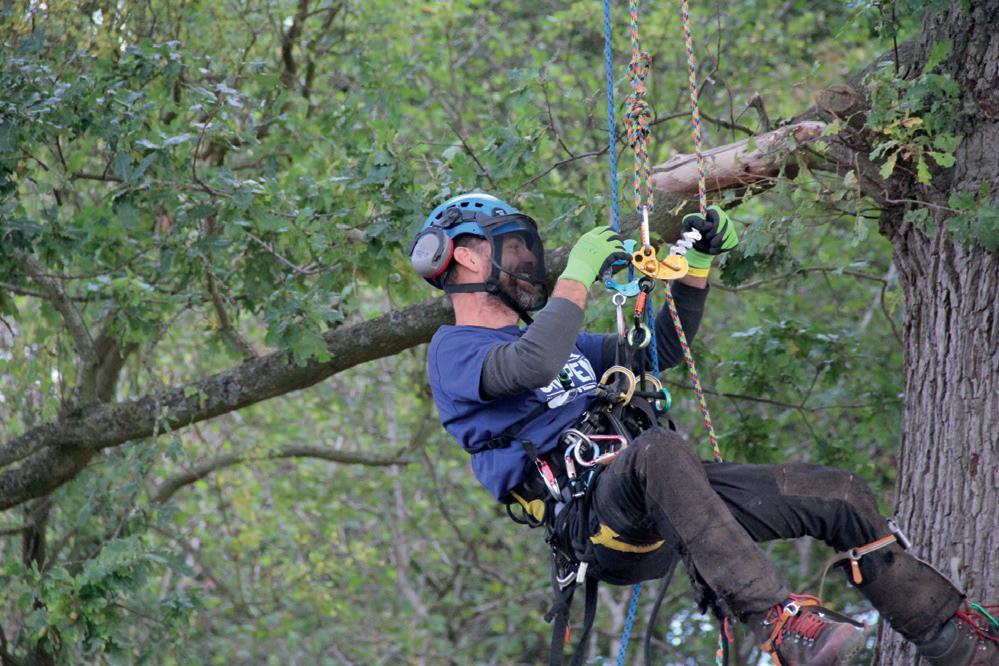

growth, and it can support levelling up in less affluent areas and create a range of skilled jobs. Now is definitely the time to be making the case to Government for the strategic importance of the industry.”
With new opportunities for tree planting becoming a running theme for the day, many returned to the Confor tent to hear a panel discussion on ‘Woodland, Hedgerows, Agroforestry and Trees’, chaired by Penny Oliver, Head of Future Farming and Transition at the Forestry Commission.





She was joined by Ewan Calcott, Head of Woodland Regulation at the Forestry Commission, Hugh Williams, Associate Director at John Clegg & Co, Jim O’Neill, Agroforestry Advisor for the Forestry Commission, and Edd Colbert, an independent Agroforestry Advisor.
Queries came from audience members representing both the worlds of forestry and farming, covering gaps in knowledge about funding, planning, design, and product outcomes. There was one clear message: there is a lot of potential to be realised.
For foresters, agroforestry presents a new way in which to utilise their skills and expand their offering. Getting trees to work as part of a farm is a widely varied and purpose-driven undertaking; Edd had plenty of examples.
“I define agroforestry as any form
of ecological integration of trees and farming elements,” he said. “Timber might be part of that system but a good design in agroforestry always starts with the objectives. For a particular farmer, it might be that they want a long-term return, and so will be selecting a system that is welladapted to timber production.
“Another farmer might be trying to reduce run-off from the land. Then they’ll be looking towards riparian buffers and not actually to an output at all. Others might be looking to diversify for shorter term gains through a short rotation coppice or fruit production.”
Hugh highlighted that the sheer diversity of the specialism could be a catalyst for a shift in thinking for foresters and their businesses.
“Just in terms of the professionalism side, I think [agroforestry] is also a huge opportunity for the classic forestry profession to really think differently about what they do.
“I think the profession has shown that it can adapt and be very agile to pests and diseases, to different species, and with all knowledge of the soil and landscapes. We’re ideally suited, therefore, to promote agroforestry and certainly to sell its products.”
Ewan pointed out that one of the easiest ways to integrate trees on farms is for the benefit of livestock. But this is also one of the biggest disconnects for foresters used to trying to keep animals away from trees to avoid timber damage.
“From a policy perspective, we’ve had 30, 40 years now of new woodlands being created and livestock being excluded. In the context of agroforestry, there is a historic relationship between using the woodland space and having animals grazing on that land.
“It has to be done sustainably and sensibly. It’s not a case of putting your animals in there for 12 months of the year, it’s got to be the right animals, at the right density, and at the right time.
“Just because we keep domesticated livestock out of woodland today as a mat
“THE FORESTRY SECTOR HAS OPPORTUNITY FOR GROWTH, AND IT CAN SUPPORT LEVELLING UP IN LESS AFFLUENT AREAS AND CREATE A RANGE OF SKILLED JOBS.”
Confor’s Richard Hunter led groups of university students on skills tours around the APF showground, introducing them to potential future employers and showing off what the sector has to offer.

The APF exhibition is a great show case for all things forestry, so the Confor team decided that we should use it show off the great careers that the sector offers.

There has been a steady increase in graduates applying for forestry roles after having completed a geography or a landbased science degree. Therefore, it was felt we should target this audience at the start of their 3rd year - before other sectors get their hooks into them.
We created a short tour that meant we could describe seed to sawn, and the students heard directly from organisations how they fit into the forestry supply chain. The incentive was to meet potential employers, the carrot was free entry to the ground.
Though we asked several universities near Ragley Hall to post our invitation on their social media and jobs pages, the idea really took off with Derby University. They hired a coach to bring students en masse. On Friday morning, 20 students and three members of staff were ushered in and introduced to forestry.
Several Confor Members stepped into the breach and gave a 10-minute overview of what they and their organisation do. More importantly, they described the
lifestyle of forestry and explained the reasons why they chose that career path.
The first stop was Tilhill, discussing the benefits of forest management and their graduate programme, followed by Cheviot Trees offering a nursery perspective. Lantra presented options for practical training, conveniently demonstrated by the Scottish School of Forestry next door. Pryor and Rickett Silviculture covered growing quality broadleaves, while AW Jenkinson ensured that the students fully understood how important wood fibre is to the UK. The tour concluded at the Forestry Commission stand where both public and private forestry was discussed.
At the start of the tour, we posed the question: “What do you know about forestry?”. The answer was blank looks and awkward shuffling. By the end, eight students had signed up for further information and the university staff left with the confidence to talk about the benefits of forestry with all their students.
Many of the tour attendees also returned to the stands in the afternoon to discuss options for the future. Given this was the first time we tried something like this, I think we can say it worked. The trick is to improve the experience next time!
exactly the same grazing as we would po tentially see. Livestock are already in our woodlands, they’re just not domesticated.”
“I very much want to get the message across that I see agroforestry as a way for farmers to keep farming - by using trees. Trees can help them do their day job, which is really what they want to carry on doing,” concluded Jim.
“If we can increase awareness of the business and environmental opportunities for the farming community, then all the better.”
Despite the soaring temperatures and sunshine outside, Neil Stoddart of Creel Consulting Ltd still garnered a lot of inter est for his talk on ‘Decarbonising Timber Transport’, presented by the Timber Trans port Forum on Saturday.
Earlier this year, Creel Consulting pro duced a report on the decarbonisation of road haulage for the Forum, laying out how electric vehicle and biofuel adoption will impact timber transport in the decades to come.
Neil expanded on the immediate action that needs to be taken: “We’ve had 120 years of developing the oil supply chain and we’ve got to change that over the next 15 years to net zero fuels.
“Whether we like it or not, we’ve got to accept that there’s government targets on this. You’re not going to be able to walk into a Volvo showroom in 10 years’ time and

pick a 750hp with a 30-litre engine or get a Scania V8 at 770hp. They won’t be for sale.
“We need to look at alternatives now. We can’t leave it too much longer.”
He touched on the expense associated with buying and running electric or hydro vehicles suitable for road haulage, acknowledging that, for the moment, diesel is still a much smaller investment. However, with new progress being made everyday to commercialise low carbon transport, the hope is that suitable vehicles will be available to meet demand in the near future, at a price point that makes economic sense.
An alternative for the immediate term is Hydrotreated Vegetable Oil (HVO), a renewable and green diesel fuel similar to biodiesel. 10 vehicles running on HVO with an added additive system (Green D+ HVO) emit the same CO2e as a single diesel machine.
This is already approved for use by steadily growing list of manufacturers, including Scania, Volvo and Renault, marking a shift in mindset that has to occur in logistics, infrastructure and timber transport as a whole for a difference to be made.
Finally, we welcomed Forestry Commission back to the Confor tent for Andy Hall, Head of Tree Health in England, to deliver an overview of the pests and diseases that pose a threat to the UK’s woodlands.
Over 200 of the entries on the UK Plant Health Risk Register impact trees. This is everything from Oak Processionary Moths and Ips typographus to Phytophthora
pluvialis and Ash dieback.
Andy discussed the immense amount of work undertaken by FC and Forest Research to identify and limit threats as they occur, as well as working with government to put funding and assistance in place to help landowners manage the issues that do occur.
“Why are we doing it?” he asked listeners. “Well, in 32 years there were only five incursions that established themselves as a problem. Then there were 20 in the 16 years after that. That is serious.
“Despite all the efforts going in by the Plant Health Services and others, things are still getting in. That’s no surprise: sometimes it’s through trade, sometimes it’s through natural movement and pathways.”
Biosecurity and vigilance were emphasised as the best ways to help, on any scale. Report anything you come across so pathways can be identified, and specific action taken to mitigate risk.
A huge thanks to all our presenters and panellists who did a wonderful job keeping our guests engaged and encouraging new perspectives. It was fantastic to see such a buzz in the marquee and we hope to come back bigger and better in two years’ time.
Many exhibitors at APF 2022 launched new products and initiatives at the show, capi talising on the event’s impressive turnout.
Rainbow Professional showed off their all-new biodegradable tree shelter, which utilises UK PEFC certified softwood residue and Bio Resin from Northern Europe. The materials are proven to break down safely in freshwater and marine environments, and the product is the first of its kind to obtain European certification for soil biodegradability.
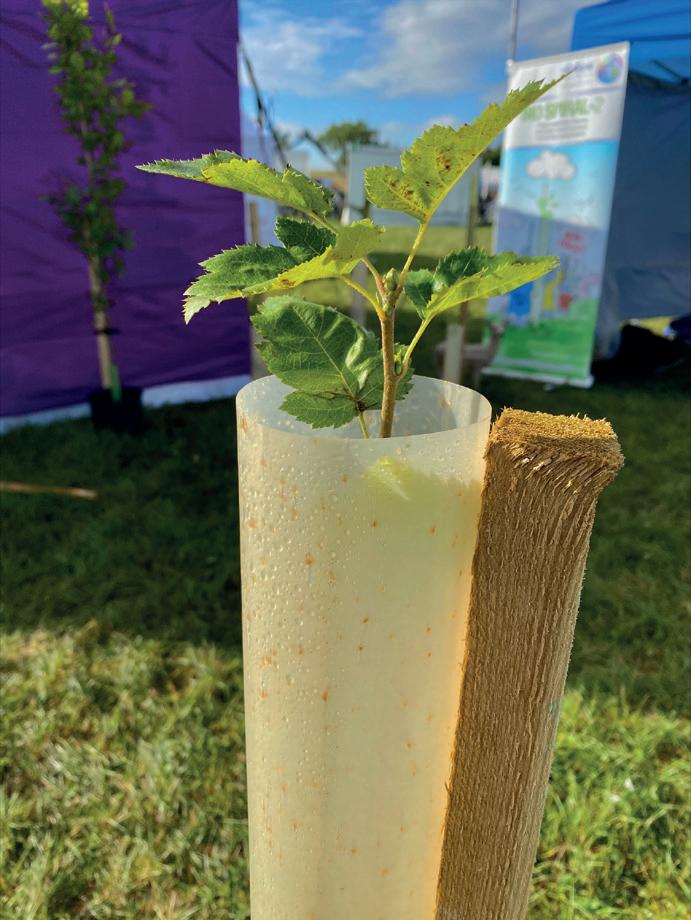
Just a short distance away, NextGen Tree Shelters also had new offerings on display, and announced a five-year warranty on all their products. After rigorous and extensive research, they are confident that their products will last the course.
Over in the Husqvarna marquee, con veniently set up right next to the Husqvarna World Pole Climbing Championships arena, visitors got a first look at two new product ranges from the brand. The 540 XP® Mark III 40cc class chainsaw is optimised for arbo rists and tree care professionals with a rear handle.

To complement the new machine, an arboriculture-aimed set of climbing gear is now also available, designed in partnership with Teufelberger and offering comfort and mobility for hours spent in canopies.
A new programme funded by the For estry Commission through the Woods into Management Forestry Innovation Funds was also kick-started at the event. North woods will accelerate innovative approach es and technology to stimulate practical action in unmanaged and undermanaged woodlands, as well as improve biodiversity and sustainability. Find out more on p48.
“I VERY MUCH WANT TO GET THE MESSAGE ACROSS THAT I SEE AGROFORESTRY AS A WAY FOR FARMERS TO KEEP FARMING –BY USING TREES.”
JIM O’NEILL, AGROFORESTRY ADVISOR FOR THE FORESTRY COMMISSIONPhoto credit: Forestry Journal











Friends of the Earth, the UK’s largest grassroots network, has published Why We Need More Trees in the UK – a look at the need for trees to cool cities, restore nature, and lessen the UK’s reliance on imported timber.
Stuart Goodall, Confor’s CEO, provid ed a supportive quote for the document, which highlights the need to increase do mestic timber production to reduce the UK’s heavy reliance on imported timber.
The UK is currently importing just over 80% of all its wood products, the world’s second largest net importer after China.
Despite predictions that global demand for timber will treble, or even quadruple, by 2050, the UK is still well off-course to hit planting targets. In England particularly, the proportion of new woodland creation that is wood-producing conifers is ex tremely low – just 12%, according to the latest Forest Research figures for 2021-22.
Against that backdrop, Stuart wel comed the Friends of the Earth report as a very significant contribution to the debate about the link between domestic wood production and global deforestation.
In his supporting statement, he said: “We applaud the call [by Friends of the Earth] for the UK to produce much more homegrown timber to reduce the signifi cant biodiversity harm caused by rising im ports from countries such as China, Brazil and Russia. Confor is ready and eager to discuss with the government, conserva tionists and farmers how a much expanded industry can deliver jobs, carbon and na
ture benefits.
“Confor welcomes the publication of this report as a very significant contribu tion to the discussion about tree planting and wood use in the UK and the link to global forests.

“It has been frustrating over the years to hear environmental organisations fail to grasp the need for more productive tree planting in the UK to secure future timber supplies. With global demand rising and the amount of wood-producing forests in the UK declining, this report comes at a very important time. I hope it will lead to a realisation that it makes economic and environmental sense to grow more of the wood we use in the UK at home.
“I look forward to working with Friends of the Earth and others to continue these vital discussions.”
Mike Childs, Head of Science and Policy at Friends of the Earth, will speak about the report at Confor’s policy conference in London on 8 December. (Register for Tim ber! Why the UK needs the wood - and the trees on the Confor website.)
The report is also backed by Lord De ben, Chair of the Climate Change Commit tee and by the Nature Friendly Farming Network.
The introduction to the report says the UK Government needs to be far more am bitious in its plans to extend forest cover and calls for an increase of one million hec tares of new productive forests.
The Trees for Timber section of the re port highlights another issue repeatedly raised by Confor - that dislike of plantation forests of the past and outdated percep tions should not influence current policy.
It says: “We can’t let previous poor prac tices hold the UK back from establishing productive forests now. There is a pressing need to eliminate imports of timber and timber products from high-risk countries and there is a growing global demand for timber.
“The UK must increase its produc tive forestry faster than ever before. And it must do so in harmony with nature and the communities who manage our land. At least 1 million hectares of new produc tive forests sounds a lot. And it is. But the UK has the land to do it, as well as land for more woodland for nature.”
More Information Read the full report here: https://bit.ly/3SkioT2
“IT HAS BEEN FRUSTRATING OVER THE YEARS TO HEAR ENVIRONMENTAL ORGANISATIONS FAIL TO GRASP THE NEED FOR MORE PRODUCTIVE TREE PLANTING IN THE UK TO SECURE FUTURE TIMBER SUPPLIES.”
Colin Palmer is the Confor special ist adviser on pesticides in forestry (now for over 40 years) and has re cently published this 62-page booklet to replace its predecessor from 15 years ago.
The new version is packed with very useful information. It covers everything you need to know about using herbicides and insecticides in UK forestry, including regulations, qualifications and safety, as well as detailed information on the chemi cals, equipment, and how to use and cali brate it.
The main forestry herbicides are glyphosate (e.g. Roundup Pro), propyza mide (Kerb Flo) and asulam (Asulox). Clopyralid (Dow Shield) is also frequently used for docks and thistles, cycloxydim (Laser) to control grasses without harm ing trees, and carfentrazone-ethyl (Shark) for foliar scorch of annual weeds.
Farm forestry adds many more chemi cals to the mix, such as pendimetha lin (Stomp), a residual for broadleaved weeds, and the similar isxoben (Flexidor).
These and more are all detailed in the booklet, alongside the chemicals not clas sified as hazardous by the Forest Steward ship Council (FSC).
Another useful section covers the
treatment of scrub, cut stumps, short rotation forestry and weeds on restock sites. Amusingly flame throwers are con sidered as generally unacceptable in the woodland environment. The Control of Substances Hazardous to Health (COSHH) assessments are fully explained, as are chemical container labels. I was interested to read that some chemicals, such as Kerb, Flexidor and Stomp, need shaking well be fore mixing.
A handy table about glyphosate and its
effectiveness with 21 different grasses and rushes also gives different dosage rates from 3 litre per treated hectare to 6 litre/ ha when controlling hard rush. Glypho sate at these higher rates can also be used on young gorse.
Additionally, the booklet features pho tos documenting the treatment of a range of broadleaved weeds including creep ing buttercup, dock, Himalayan balsam, hogweed, Japanese knotweed, nettle, ragwort, rosebay willowherb, bracken, broom, bramble, gorse and ivy.

The final section deals with insecticides and treatment of weevils on restock sites, where Gazelle is by far the most common ly used insecticide.
Overall, the guide is very useful to have on hand and provides a good overview of relevant information for safe and effective pesticide use in forestry.
Weed and Pest Control in Forestry: A guide to the safe and effective use of crop protection products in forestry and farm woodlands by Colin Palmer ISBN 978-1-897781-43-2 £17.95 + delivery
Available to order at www.ruralservices.info
Former housing charity leader to take the helm on drive for genetically-improved broadleaves
Future Trees Trust has announced John McLaughlin (pictured right) will be taking over as their new Chief Executive.
The organisation is the UK’s only char ity dedicated to improving broadleaved trees by selective breeding, delivering environmental, economic and wellbeing benefits for current and future genera tions.
John joins from Response, one of the largest mental health and housing chari ties in the Thames Valley, where he has been CEO for 18 years. He spent his early career working in the NHS and has also served as Executive Chair of the RAW Workshop - a wood recycling charity that provides employment for vulnerable adults.

John will be supporting Future Trees Trusts’ strategy to promote resilient, healthy and productive woodlands in the UK. He will be working to realise a vision
for all productive woodlands in the UK to contain a proportion of genetically-im proved trees, primarily for the purpose of producing wood for use in net zero car bon social housing and public build ings.
He said: “I am really excited to be joining Future Trees Trust as their new Chief Executive. In the short time I have spent with FTT, I have been incredi bly impressed with the passion and commitment of everyone I have met.
“With its new stra tegic plan and am bitions to increase impact, it is a great time to be joining. I look forward to meeting all our partners and
supporters over the coming months.”
In addition to the core work of improve ment for timber, tree health, and enhanc ing woodland-level resilience through in creased use of minor broadleaved species and mixed planting, John will also be upholding the charity’s continued sup port for young foresters in their early careers via a scholarship programme for placement of early-career forest ers and researchers.
Jo Clark, Head of Research at Fu ture Trees Trust added: “It’s great to have John as the new CEO of Future Trees Trust. We are very excited to have such an experienced CEO on board to help us develop as an organisation and take our work forward in providing industry with qualified and tested forest reproductive material.”
Eamonn Wall reviews Weed and Pest Control in Forestry, a practical new publication from pesticide specialist Colin Palmer.



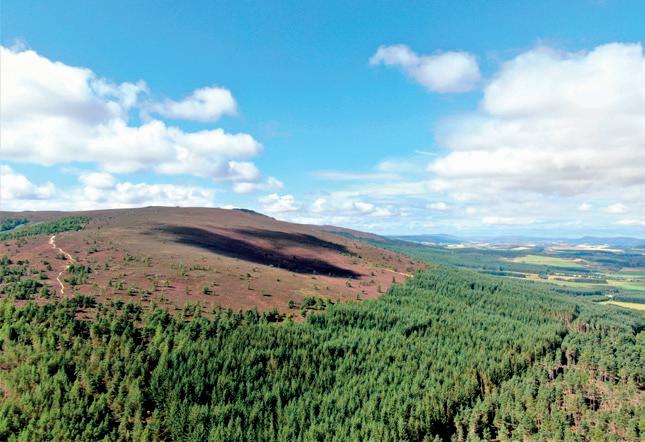
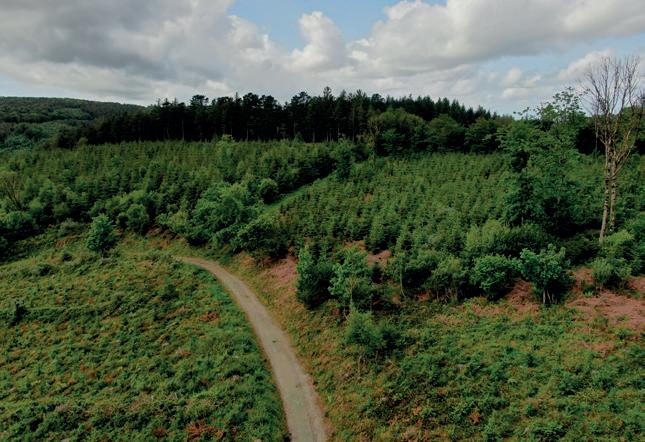



Andrew Bronwin & Co has been synonymous with for est management in Wales for over 20 years. In 2021, the business merged with Ab bey Forestry, based just a hop, skip and jump over the border in Worcestershire, to broaden their reach across the Marches and Midlands as well.
Earlier this year, the resultant Bronwin & Abbey joined the Velcourt Group, open ing up even more opportunities across the rural sector.
“Merging with Velcourt was possibly a sideways step by what some people may perceive,” said Robert South, Operations Manager. “Our vision is that, in the future, it won’t be agriculture and forestry, it will be land management. Breaking down those barriers between forestry and agriculture is actually quite good.

“The heart of our work is in traditional estates: complex by nature, multiple stake holders, generally quite difficult.
“That’s where our specialism is, in the detail. Part of the reason behind joining up with Velcourt was maintaining our in
dependent stance. We did not want to be swallowed up by one of our larger com petitors.”
Robert has been around long enough to gain a decent perspective. He joined An drew Bronwin & Co eight years ago as a Forest Manager, working up to Harvesting Manager and eventually to his current role. He laughed when asked what his day-today work looks like.

“I’m a general dogsbody, really,” he ad mitted. “My role is primarily around tech nical forestry, whether that’s harvesting, haulage, civils, tree surgery – overseeing and managing those operations for health and safety compliance, along with ensur ing compliance with all of our ISO certi fications and running operations on the ground.
“I’m only in the office a day a week. If I was stuck in an office, I would go mad. I enjoy being out, I enjoy the challenge.”
‘Challenge’ is a theme that permeates Robert’s view on the industry and what needs to be done to ensure the good work happening in the sector can continue un impeded.
“The industry, particularly in Wales, is being suppressed by government, to some extent, and that is predominately down to lack of education,” he said. “Everyone, including ministers and some very intel lectual, professional individuals, don’t re alise that the roof on their house is made of wood. They don’t make that connection and it’s a huge problem. For years as an in dustry, we’ve been very good at preaching to ourselves, and the tide needs to change.
“We need to appear, as an industry, forward-thinking and modern. I had a very interesting comment from a client, who said ‘oh, I bet your meetings are all blokes sat around in chequered shirts’. That’s not a great image but it’s what’s ingrained in everybody’s heads.
“As a company, I’m very proud to say that, though we’re small, our workforce at Bronwin & Abbey is 50% female. We’ve got British, Spanish and Ukrainian staff. People diversity is something our industry lacks.
“But the industry as a whole, because of that outdated impression, doesn’t at tract a diverse range of applications. We don’t portray that we are multi-disciplined,
“Many farms and estates are looking to forestry to deliver on biodiversity and natural capital agendas, with an eye on the opportunities from sequestering carbon in addition to supplying the UK’s timber markets.
“Opportunities exist to realise the potential of established woodland in addition to plant new land areas which hitherto have been marginal farming land.

“The UK Government has set out its aspirations for tree planting alongside its agenda for UK agriculture: inevitably this will result in considerable change and will necessitate experienced and technically proficient leadership within the sector. Velcourt has a strong reputation of innovation and delivery in the farming sector, as do the Bronwin & Abbey team in the forestry world.
“Against this backdrop, it’s an incredibly exciting time for both our own and the Bronwin & Abbey team to work together to deliver for farmers, forest and landowners.”
skilled professionals. We need to have that education of the masses, whether that’s in secondary schools or in universities.
“A forester now, a good forester, is eve rything from a silviculturist to a civil engi neer at times.”
The evolution of the sector and the high level of skill required to work can be a great opportunity, not just for recruitment and bringing new talent into the industry, but also in what companied like Bronwin & Abbey can offer clients.
“The modern age of forestry is about openness, transparency and relationships. Our clients value us because we are com pletely transparent about everything we do, and because we value them.
“We’re the first company in Europe to have digital timber tracking software. Our clients can track their loads from their woods to the mill. There’s no ambiguity –it’s all there, tracked, monitored, and our clients like that. Everything we do is in their best interests because that’s where our core values lie.

“Even all the way out to how we do our woodland creations. We don’t slap square blocks of Sitka on a mountain anymore. We plant well-designed, diverse wood lands.”
And, in the end, that’s what forestry is about - the trees left behind.
“What gets me out of bed in the morn ing is doing something that makes land owners appreciate and manage their woods. We are a professional, multi-disci plined industry, with great opportunity to leave a hell of a legacy behind.
“These woodlands that we design now are a mark in time on the landscape – for ever. But we still live in the shadow of our grandfathers’ mistakes when discussing or consulting on woodland creation.”
Robert sits on the Confor Committee for Wales, working to secure the future of forestry.








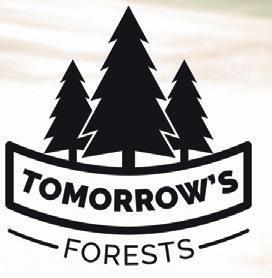
Forestry assets in the United Kingdom are commonly held in trusts and oth er corporate entities that are incor porated in non-UK jurisdictions – Channel Island trusts being a particularly common ownership vehicle.

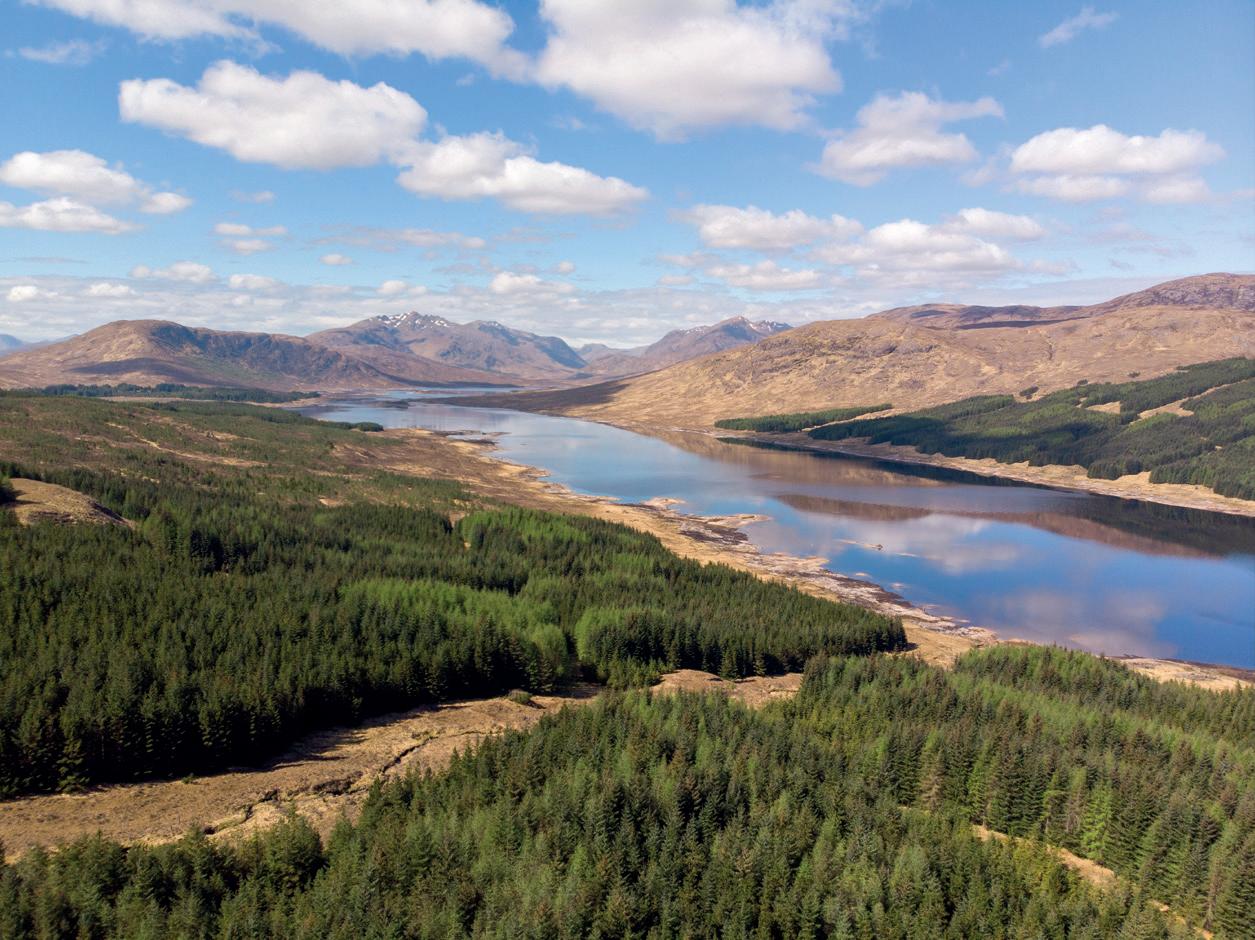
The arrival of the Register of Overseas Entities (ROE) on 1 August 2022 brought with it important changes for overseas en tities involved in UK land ownership.
The ROE is a new register introduced by the Economic Crime (Transparency and Enforcement) Act 2022 which seeks to promote greater transparency and combat illicit money laundering by overseas enti ties. An overseas entity must make a sub mission to the ROE if:
• it owns or is the tenant under a long lease of ROE property;
• between 28 February 2022 and 31 Janu ary 2023, it disposed or disposes of ROE property; and/or
• it wants to buy or take a long lease of any UK property
ROE property is property where the overseas entity’s title or lease was regis tered in Scotland on/after 8 December 2014, or in England and Wales on/after 1 January 1999. A long lease in Scotland is a lease with a term of over 20 years and in England is a lease with a term of seven years or more.
The overseas entity must provide infor mation about itself, its beneficial owners and, in certain cases, its managing officers. This information is published in the ROE (except date of birth and residential ad dress information) and must be updated annually by the overseas entity.
For ROE purposes, an overseas entity is a body corporate, partnership or other entity that is a legal person in a non-UK country and governed by that non-UK country’s laws. If you are an overseas individual who owns, or has a long lease of UK property, the ROE does not apply.
The ROE application must be submitted online to Companies House. However, the overseas entity must first:
• Identify its beneficial owners. This is similar (although not identical) to identi
The new Register of Overseas Entities requires overseas entities that own land or property in the UK to declare their beneficial owners and/or managing officers.
fying persons of significant control when registering UK companies. For example, it captures those holding more than 25% of the shares and/or voting rights and those who exercise significant influence or con trol over the entity.
• Gather the required information about its beneficial owners and/or (if required) managing officers.
• Issue its beneficial owners with an infor mation notice giving them one month to confirm or correct their information.
• Arrange for a UK regulated agent super vised for Anti Money Laundering purposes to verify the information.
There is a £100 fee for the ROE registra tion. Once it accepts the ROE application, Companies House will issue a unique ROE identifier number for the overseas entity.
Overseas entities that currently hold ROE property (or have disposed of ROE prop erty since 28 February 2022) must register in the ROE by 31 January 2023. However, if an overseas entity wishes to purchase, or acquire a long lease of, UK property be fore then, it will need to register in the ROE
prior to completion of the purchase/acqui sition. This is due to the bar to property registration that is noted below.
There are criminal sanctions, which can include a fine or imprisonment. In addi tion, a failure to register in the ROE (or to update annually) means that the overseas entity will be prevented from completing certain transactions involving UK property, because:
• As of 5 September 2022, overseas en tities are unable to register freehold/herit able or leasehold title to UK property in the UK property registers without an up-todate ROE registration.
• From 1 February 2023, overseas entities will be unable to dispose of or grant a long lease or charge/standard security over ROE property without an up-to-date ROE registration. There are some exceptions to this, but they are limited.
As a result, a failure to comply with the ROE rules can substantially delay the com pletion of transactions.
It is vital that overseas entities review their existing UK titles and leases now so that, if they need to register in the ROE, they can begin the registration process as soon as possible.
Confor has partnered with law firms Brodies LLP and Atkinson Ritson Solicitors to run a legal clinic for members looking for guidance on key issues that impact forest owners and the forestry sector.
Whether your query is employment law, health & safety, planning, tax or property-related, contact one of our partners for a free initial consultation.
For members based anywhere in the UK Brodies LLP 0131 228 3777 www.brodies.com confor@brodies.com
For members based in England/Wales Atkinson Ritson Solicitors 01228 525221 www.atkinsonritson.co.uk info@atkinsonritson.co.uk

The ongoing war in the Ukraine has had a significant impact on the global economy.
As sanctions and tariffs impact on global trade patterns, we are seeing food shortages, escalating energy prices, disruption to shipping and now increased currency volatility. After the recent COVID pandemic this is another significant economic shock that is creating uncertainty and impacting on consumer confidence.
Inflation in most western consumer economies is running at over 10% and is forecast to reach 18% in the UK by 2023. Energy and food have seen the biggest increases and that has had a severe impact on disposable income.
Governments still reeling from the costs of the COVID pandemic are now faced with the direct costs of supporting the war effort in Ukraine, at the same time as domestic economies come under serious pressure from inflation for the first time in over 20 years.
Global demand has fallen steadily through the second quarter of 2022 to the point where most processors are battling to reduce production capacity so it comes back into balance with demand and prices can be stabilised.
Sadly, that does not appear to be the case currently and there are signs of a ‘race
to the bottom’ on timber prices, particularly in the carcassing sector.
The slowdown in the US housing market has seen US 4 X 2 KD spruce pine fir fall from a peak of $1,400 per thousand board feet to $465 in late August. It is interesting to note that this seasonal price trough is very similar to that seen in 2020 and 2021.
It remains to be seen whether this is a price trough or if it’s simply the ‘new normal’.
Though the situation in the solid wood market is pretty dire, there are some positive developments in other market sectors, particularly the energy wood market.
The massive increases in fossil fuel prices have increased demand for woodfuel substantially at the same time as supplies of energy wood from Russian and Belarus have been stopped by sanctions, whilst the supplies from Ukraine have been reduced by the war.
It is estimated that Russia supplied around 2 million tonnes of wood pellets to the global market annually, which primarily went to European buyers. This supply has stopped altogether, and it is estimated an other 1 million tonnes produced annually in Ukraine and its hinterlands needs to be re placed as well. This is approximately 10% of Europe’s wood pellet consumption, based
on 2019 figures.
Prices for wood pellets have soared from around £200 per tonne in the UK to over £400. In central Europe prices have also doubled whilst in the Baltic states it is reported prices have tripled.
Increased demand over the late summer has already reduced stocks and producers are encouraging customers to stock up early.
It is of particular interest to note that in central Europe (Germany, Austria, Czech Republic) slow demand and low prices for side boards (12, 14 and 16mm) have led to sawmills adjusting cutting patterns to produce more woodchips as there is strong demand and good prices for these.
Firewood prices have also rocketed and reached a historical high of €125 per solid cubic meter.
The Ukrainian conflict sanctions appear now to be starting to reduce timber exports from Russia and Ukraine, which together amounted to $17 billion in 2021.
There are a number of impacts of the sanctions:
a) Finance, insurance and credit are restricted.
b) Russian and Belarussian timber is labelled “conflict timber” as opposed to certified or controlled wood.
c) Availability of shipping to carry export cargos is restricted.
Significant logistic challenges in redirecting timber from Northwest Russia to China.

Western timber companies closing or selling their stakes in Russian plants.
There is also impact further down the supply chain as furniture manufacturers in China will be unable to export Russian “conflict timber” to European, North American and Pan Asian markets requiring certified timber.
In summary, concerns about the Ukraine conflict and global recession fears have slowed demand for timber but in the longer-term supply constraints will increasingly influence the global trade patterns.
In the UK, the softwood market has continued its downward trend; there are high stocks of imported material on the quays whilst lack of customer confidence has led to the merchant sector operating on minimum stock levels, purchasing only what they need at the last minute.
This has led to timber importers





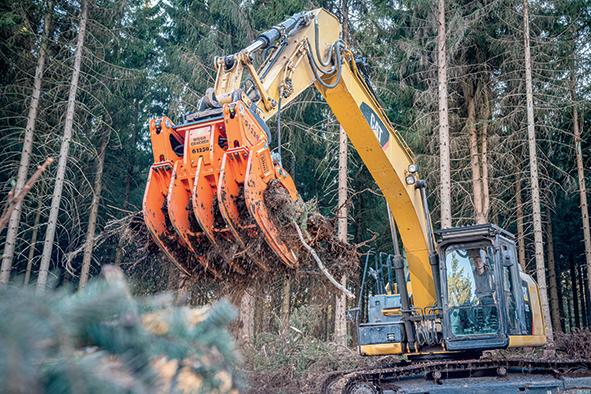





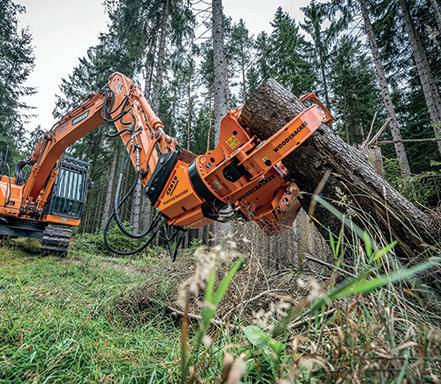







Product Lower price Upper price Trend
Log 16 (Spruce Df) £75.00 £85.00
Bar 14 £65.00 £75.00
SRW £55.00 £65.00
Fencing £60.00 £70.00
H Wood firewood* £75.00 £85.00
Product Lower price Upper price Trend
Log 16 (Spruce Df) £70.00 £80.00
= = = =
Bar 14 £60.00 £70.00
= = = =
* £55 seems to be the norm for processor grade 10 to 40cm
SRW £50.00 £60.00
Fencing £60.00 £65.00
H Wood firewood £65.00 £75.00
(These prices are for guidance purposes only and are based on historic market information.)
reducing prices to try and generate sales but has had the unfortunate effect of chasing the market down, so they sell the same volume of timber for less money!
In many instances, the importers are losing money on every load they sell. This has a knock-on effect on the domestic producers who are frantically trying to reduce production volumes to match demand. While this has stabilised prices in the past, we are not yet at the level where prices appear to have bottomed out.
It will be interesting to see what prices replacement imported stock can be purchased at as log prices remain high in Scandinavia and central Europe. Even at current levels, the high log prices in the Baltics mean that these mills cannot afford to supply the UK.
At some point, the impact of reduced import volumes due to bans on Russian wood, economic constraints on Baltic wood and higher costs in Scandinavia will surely bring supply and demand back into balance and arrest the downward price spiral.
As the UK sawmills take drastic steps to reduce their production capacity, this significantly reduces both their roundwood intake and their output of co-products such as woodchips, sawdust and shavings. These are a core feedstock of both the board mills (Egger, Iggesund, Kronospan and Norbord West Fraser) as well as the large industrial biomass users, so any significant reduction in supply has to be replaced with an alternative feedstock (roundwood or recycled fibre).
These are significant volume users so any change in their purchasing patterns has
a noticeable impact on the standing sales market. In England and Wales roadside stocks of small roundwood have fallen quickly over the last month as biomass demand kicks in, and Kronospan look to increase roundwood purchasing to offset reduced sawmill co-product intake.
So currently we have falling demand and prices for conifer sawlogs, but also increasing demand for small roundwood. At the moment there are still significant volumes of windblown timber to be harvested in the northeast of England and east of Scotland, but further south there appears to be less timber on the market. Sawlog prices are falling but small roundwood prices are starting to creep back up.
The hardwood season is just beginning in the UK and the domestic mills are starting to look for supplies.
Oak demand is healthy and supply from Europe is still problematic so the outlook for the UK market remains good, provided consumer demand holds up. Hopefully the strong prices for UK oak seen over the last couple of years will be maintained.
The export market has had a torrid time during Covid, and the recent Ukraine conflict has caused significant disruption to shipping.
There are now signs that the situation is improving: shipping rates and availability have stabilised and demand in the Far East is improving as global sanctions start to reduce availability of Russian and Belarusian timber.
The demand for ash is strong, supplies
from Europe are tailing off as the full impact of ash dieback is felt and buyers are increasingly looking to the UK for their supplies
Beech demand is also improving provided the quality is correct. A lack of beech parcels being offered to market so far this year has meant the export market has not yet had a chance to benchmark itself against domestic markets.
Poplar demand has been slow recently and really needs some new market options, which may be possible as the UK customs situation settles down post Brexit.
For hardwood owners and agents planning felling coupes this winter, it is important to understand that the export markets are a viable option but need some extra planning:
a) The markets are species specific. b) The minimum quantity is four containers per species (100m3).
c) Access for artics and space to load containers is essential.
So, for a mixed hardwood parcel of ash, beech and sycamore there would need to be 100m3 or more of sawlogs of each species and space to measure and load them.
Firewood prices have steadily crept up on the back of this very strong demand.
The firewood market has been exceptionally strong this year. One major retailer has reported that his sales in August are three times higher than the same period last year, production is running flat out, and he is struggling to build stock. Local producers are reporting similar increased early season demand.
In areas where there are not large supplies of diseased ash, roadside firewood prices have increased significantly over the year and prices of £75 to £85 per tonne at roadside are now being achieved.
Contact If you wish to discuss parcels of timber you would like to market, please contact Oliver Combe on 07771 958975, oliver.combe@timberauctions.co.uk for free independent marketing advice.








The Scottish Forestry Trust is delighted to announce the appointment of three new Trustees from 1 January 2023.
Professor Adam Kleczkowski is a statistician and mathematician with over 30 years of experience addressing plant and tree health. His work is dedi cated to understanding how pests and diseases affect UK and global forests and what can be done to prevent such devastating outbreaks as Ash Dieback or Emerald Ash Borer.

He firmly believes that we can only start to understand the links between forestry, ecology, economics and health by bringing together different disciplines and has written multiple popular science articles on epidemiol ogy and statistics.
Trefor Owen FICFor is a chartered forester and senior leader in large scale sustainable land management and cli mate transition and adaptation. He is a strong advocate for sustainable resource use, multi-dimensional land management, skills & learning and fur ther development of the bio-economy.
Trefor is also a member of Ban gor University’s Accelerator Advisory Board that supports science and tech nology start-ups in North Wales, to drive the growth of innovative busi nesses in the region.
Dr Ian Willoughby FICFor is a Prin cipal Silviculturist with Forest Research and has particular research expertise in integrated forest vegetation manage ment and early silviculture. In both cas es his ethos is to deliver clear, practical solutions for forest managers, based on undertaking high quality peer re viewed science.
His research on early silviculture fo cuses on adapting forest regeneration to increase resilience to climate change and biotic threats.
Scottish Forestry Trust Chair Bob McIntosh welcomed the appointments: “The Trust is very pleased that we have been able to attract such a high calibre of new Trustees.
“Earlier this year, the Trust published its new 10 Year Development Plan, set ting new strategic priorities and seek ing to increase the funds available to support forestry research and educa tion, which our new Trustees can help deliver.”
A lack of upskilling opportunities in the sector is hindering the UK’s progress toward net zero and a future-proof forestry industry, according to ICF Executive Director.
The Institute of Chartered Foresters (ICF) has launched a leadership pro gramme in a bid to address the for estry skills shortage and drive the industry forward.
The Emerging Leader Programme, de veloped in partnership with Clore Social Leadership and funded by the Defra Trees Call to Action fund, will develop skills that will ensure effective management of our trees, forests and woodlands in order to face planting targets, climate change miti gation, the biodiversity crisis and the rising demand for timber and wood-based prod ucts.
ICF Executive Director Louise Simpson said: “This is a pivotal moment for forestry. The industry is under huge pressure, but the workforce is chronically under-resourced and there is an acute shortage of skills.
“This has grave consequences for meet ing the UK’s climate responsibilities and we urge the new government to grow a strong and resilient forestry sector that delivers on its ambitions for net zero, nature recovery and the green economy.”
Tree planting figures in the UK fall far short of government ambitions to plant 30,000ha of trees every year by 2025. This training has been launched in response to ICF’s claim that it will be impossible to meet UK environmental goals unless the existing workforce is expanded and up
expand, upskill and diversify our workforce and that needs to start in the classroom so that young people recognise it as an excit ing career. It is also crucial to nurture the talent we have and foster tomorrow’s lead ers.
“We are delighted to be delivering a leadership programme which we hope will attract an exceptional and diverse cohort of future leaders which will in turn shape forestry in the years to come. This initiative will give them the confidence and courage to make real changes and deliver modern sustainable forestry that works for the UK environment, economy and society.”
Applications are currently being con sidered and 35 successful candidates from across the UK will take part in the sixmonth scheme.
The first ever degree-level forestry ap prenticeship scheme was also launched in September by a partnership between the ICF, the Forestry Commission and Cumbria University.
“These are gamechangers for the sector but more needs to be done,” said Louise. “Forestry comprises many small organisa tions which don’t have the resources to take on apprentices or offer work experi ence. Without funding, education, politi cal leadership, and a coherent approach throughout the UK, it is very difficult to make any real progress.

































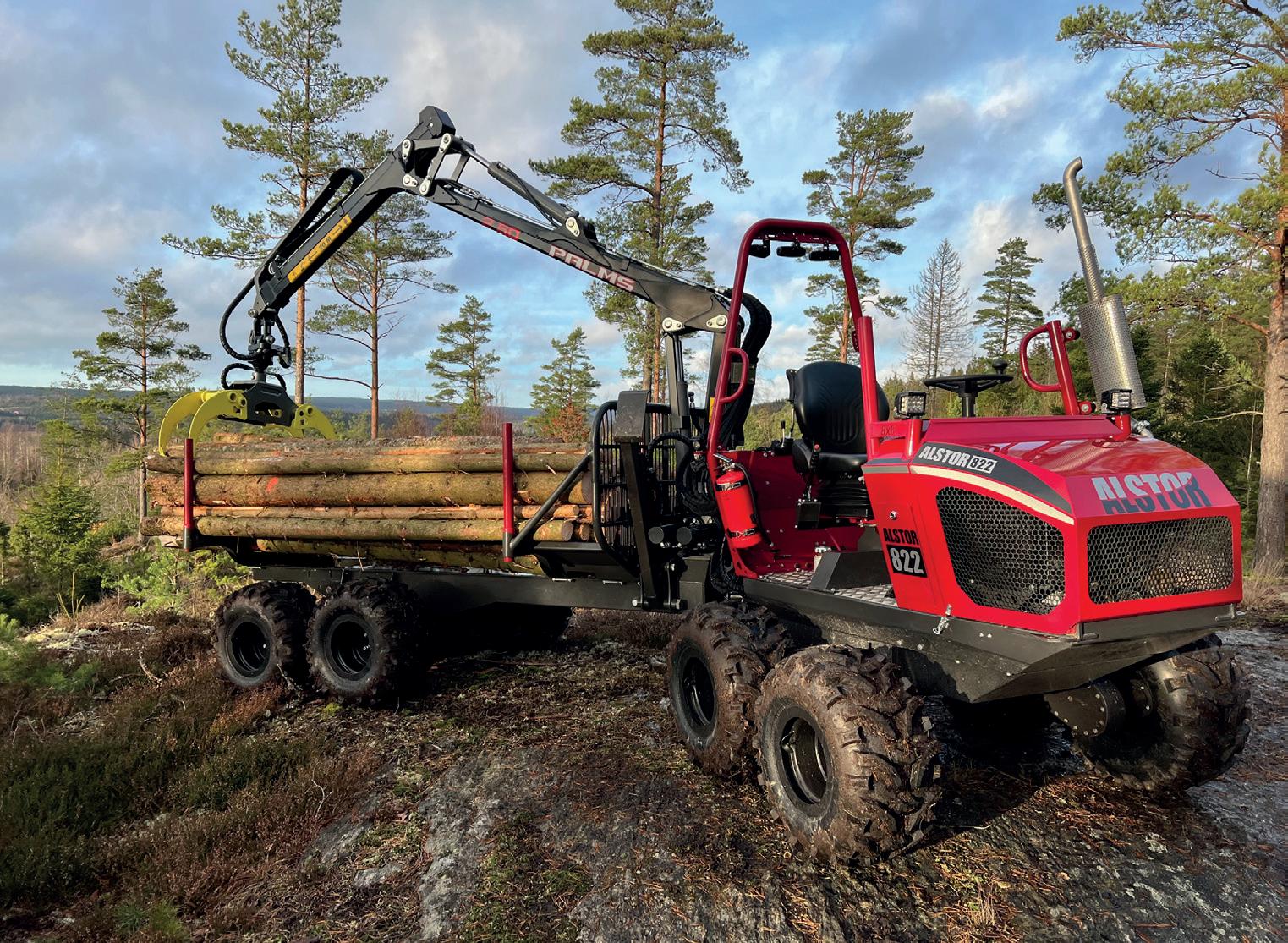




Conversations about wood, particularly its use in construction, are often centred around its ability to store carbon and reduce the embodied carbon value of a building. But wood products can also promote circularity in construction – and reducing waste and reducing carbon emissions go hand-inhand when it comes to fighting climate change.
The linear economy follows the process of taking resources from the environment, manufacturing products, and throwing those products away at the end of their life.
By contrast, a circular economy seeks to limit the use of resources from earth, recover as much as possible and reduce and eliminate waste through re-use.
One of the key principles of a circular economy model is to circulate products and materials for as long as possible, rather than throw them into landfill.

Timber fits neatly into the circular model, with numerous options for repairing, reusing and refurbishing timber products before they finally biodegrade and return to the earth.
But some industry innovators are making wood go further by finding ways to make wood products last even longer.
It is already common to see upcycled pallets used as furniture, floorboards recycled from previous buildings, and

products such as chipboard manufactured with recycled wood material.
Reclaimed and salvaged timber have long been a feature of garden and interior design, with reclaimed railway sleepers often used in garden projects and reclaimed scaffold boards turned into shelving.
Collectives and cooperatives around the country such as The Bristol Wood Recycling Project and Community Wood Recycling are taking these initiatives to the next level, providing a service to collect and store timber such as skirting boards,
but also providing a workshop to turn some of the reclaimed timber into new products for sale.
Cross-laminated timber made from recycled wood Engineered timber products such as cross-laminated timber (CLT) are gaining popularity as sustainable structural alternatives to concrete and steel. However, most CLT is manufactured from primary virgin wood materials.
A project from Build-in-Wood looked at how to create CLT with recycled wood products. The practical experiments took discarded slats that had been cleaned and planed and glued them into five-layered CLT prototypes. On testing, prototypes showed positive results across a variety of characteristics including strength, adhesiveness and shear properties.
The research shows that recycled wood products can be used in mass timber products and systems and products such as CLT can become part of a circular economic model.
Recycling MDF Technology developed by MDF Recovery is designed to recover high quality wood fibres from waste MDF.
The technology separates fibres from the resin (glue) used in MDF production, thereby reversing the manufacturing process. This will allow the MDF manufacturing industry to access a new source of raw material, easing constraints
Reused and reclaimed wood holds limitless potential for the circular economy, writes Andy Leitch, Director of Wood for Good.
“EVERY YEAR AROUND 18 MILLION PALLETS ARE PRODUCED FOR THE UK CONSTRUCTION INDUSTRY – BUT LESS THAN 10% ARE CURRENTLY REUSED.”
on traditional linear supply chains, reducing waste and keeping MDF fibres embedded in products for generations to come.
The recovered fibres are also well suited to the natural fibre insulation market and can be used to produce high quality loose, flexible and rigid products.
Every year around 18 million pallets are produced for the UK construction industry – but less than 10% are currently reused. This is in stark contrast to the FMCG retail sector where pallet reuse is estimated to be around 98%.
To improve re-use of pallets in the construction sector, The Pallet LOOP is a circular economy deposit-based service with a nationwide collection network. Its range of distinctive green pallets have been engineered to last and with a deposit per pallet system, manufacturers and merchants are incentivised to retain and return the pallets so they can be re-used.
If we want to embrace circularity in construction, it’s clear that we need to start reusing more, wasting less, and rethinking how we design our buildings. With the growing focus on sustainability across the built environment, architects are starting to design buildings that can be easily dismantled, and the materials reused.
And as more innovative ways to prolong the use of timber products emerge, wood is set to remain at the heart of the circular economy.
• The Bristol Wood Recycling Project bwrp.org.uk
• Community Wood Recycling communitywoodrecycling.org.uk
• Build-in-Wood build-in-wood.eu
• MDF Recovery mdfrecovery.co.uk

• The Pallet LOOP thepalletloop.com
A£1.2m grant designed to boost do mestic tree seed production, create green jobs, help meet the increased demand for trees and achieve ambitious net zero targets has opened for applications.
The Seed Sourcing Grant (SSG) is look ing to enhance the quantity, quality and diversity of tree seed sources in England. Most tree seed planted in the UK is of Brit ish origin, but evidence suggests that British seed sources may struggle to meet future demand across all species and global short ages of tree seed are a growing concern.
Richard Stanford, Forestry Commis sion Chief Executive, said: “Seed sourcing is an essential part of tree production and one that can sometimes be overlooked. As planting rates increase, so too will the de mand for tree seed.
“This funding will give a vital boost to domestic tree seed production, helping to create diverse and thus resilient woodlands across our country. This will both help meet our ambitious tree planting targets and en sure the resilience of woodlands so they can thrive in the uncertain future.”
The SSG also aims to increase the range of species and provenances available in England’s seed supply. As such, the scheme is open to proposals covering all species in cluded in the UK Forest Reproductive Mate rial (FRM) scheme.
However, the priority for financial sup port will be projects that align with the Tree Seed Species Strategies, developed as part of the Sustainable Seed Sourcing Project, which identify 23 priority tree species and provide suggested ideal approaches.
This will be crucial for creating diverse and resilient woodlands, which are better able to adapt to future climate conditions as well as pests and diseases. It will also reduce the need to buy seed from the international market, lowering the risk of importing harm
• Management of existing seed stands –the groups of trees in the landscape from which seed is collected - to ensure they are productive for seed collectors.

• Desk studies and field studies to identify and bring additional seed stands onto the National Register of Basic material.
• Planning and planting of new seed stands.
• Planning and planting of new seed or chards – which are planted using seed or clonal material from known parents outside of the natural landscape in an area conveni ent for seed collectors
• Some activities will take time to imple ment, and so multi-year funding will be available up until March 2025.
The SSG is open to any UK-based public, private, or third sector organisation and up to £400,000 will be made available each fi nancial year between 2022/23 and 2024/25.
The final deadline for applications is 13 November 2022. Forestry Commission and Defra will host a webinar providing an over view of the grant and application process in October.
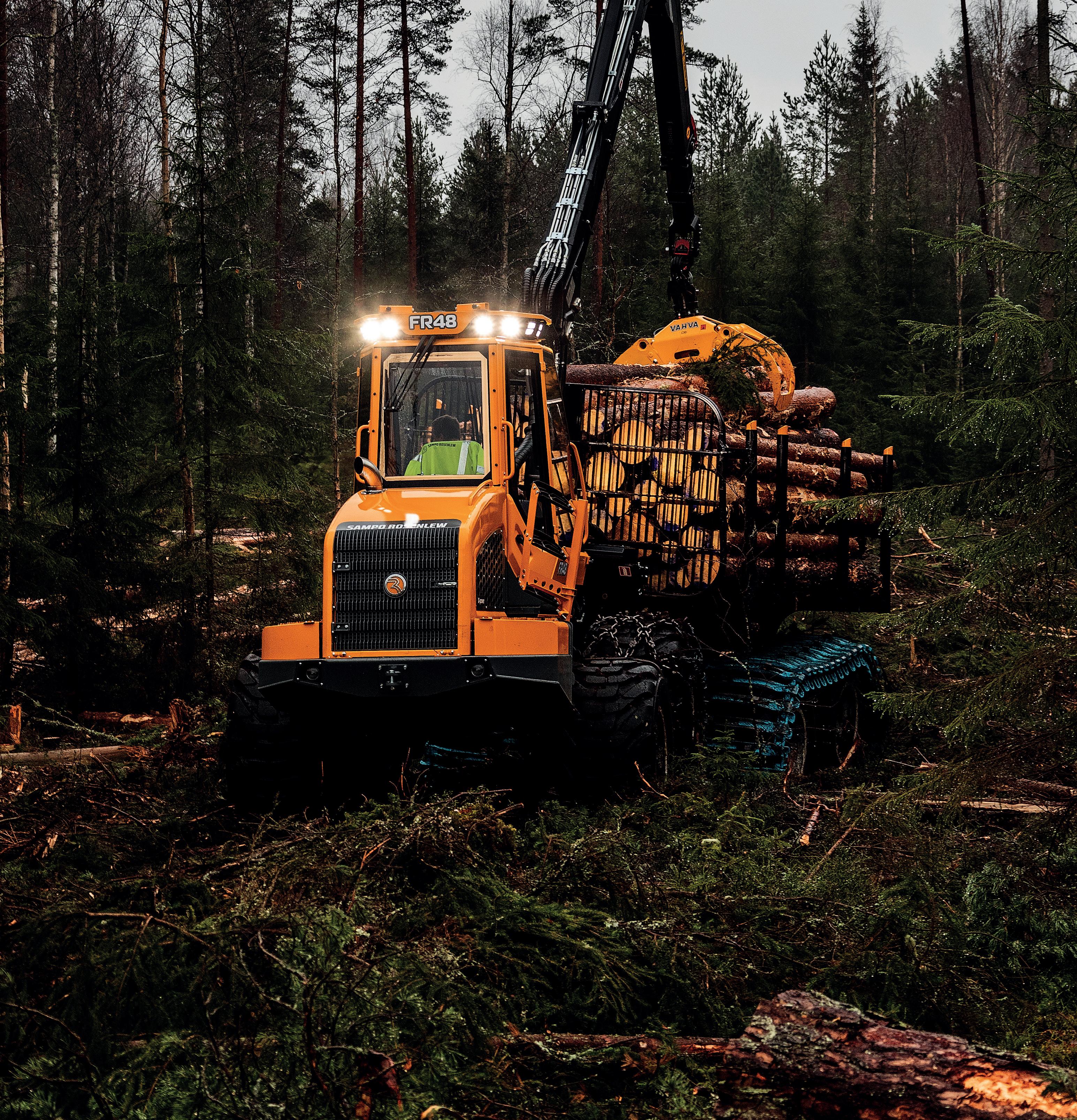





In September, a new three-year programme, Northwoods, was launched to bring areas of woodland into active management in Yorkshire and the North East of England. Rosanna Curtis, Northwoods Programme Lead, shares the scope of the initiative.
Funded by the Forestry Commis sion through the Woods into Management Forestry Innovation Funds (WiMFIF) as part of the UK Government’s Nature for Climate Fund, Northwoods has been established to work with forestry businesses and woodland owners to bring woodlands that aren’t cur rently being managed into management, and to work with companies and individu als who are currently looking to innovate or who are currently innovating in all aspects of forestry management.
Northwoods will use innovative ap proaches and technology across the for estry supply chain, markets, and ownership


community to stimulate practical action in unmanaged and undermanaged wood lands, as well as improve biodiversity and sustainability. The programme will deliver events, webinars, networking, innovation demonstrations (including access to for estry sites) as well as canvas public opinion on woodland management.
Northwoods is managed by Alnwickbased low carbon heat and forestry con sultancy re:heat, joined by a consortium of industry experts, including forestry charity Sylva Foundation, timber marketing ser vice Timber Auctions, forestry manage ment and training consultancy RDI Asso ciates, rural development advisor Martin
Glynn FICFor, and finance specialists Green Business Finance.
The launch of Northwoods comes as a result of a Woodland Management Focus Area Pilot (funded by WiMFIF Round 1 and also delivered by re:heat and the North woods consortium), that identified unman aged woodlands in the wider North East and Yorkshire area with the lowest barri ers into management, using Geographic Information Systems (GIS) integrated with Multi-Criteria Decision Making Analysis (MCDA).
The methodology defined barriers to and benefits of managing woodland in cluding proximity to roads, water courses,
and designated areas. Unmanaged wood lands were identified using the Forestry Commission’s Managed Woodland Head line Performance Indicator dataset. Each pocket of unmanaged woodland was des ignated a score depending on its proximity to the barriers and benefits.
Overall, it was found that most of the currently unmanaged woodlands in the North East and Yorkshire areas have me dium to high suitability for management in terms of their manageability and the ben efits derived from bringing these wood lands into management. As a result, the Northwoods programme will explore a raft of forestry innovation areas, including elec trification of the forest, new and emerging markets, the rise of mapping technology, such as drones and satellites, and smallscale harvesting technology to bring these woodlands into management.
Over the course of the three-year North woods programme there will be an ongo ing programme of services for participants. Some of the key activities include:
A major aspect of the programme will be to provide participating innovative compa nies with access to woodland sites in or der to demonstrate novel technology, tools and techniques to stimulate action in un managed and undermanaged woodlands, as well as practical advice and insights to the market.
The Northwoods consortium is highly ex perienced and can provide a broad range of woodland management expertise. Par ticipants in the programme will be able to access support through events, networking and one-to-one consultations.
Access events, webinars and seminars de livered by experts from the Northwoods consortium and guest contributors from across the sector.
These will cover business support, be ing investment ready, innovation support and wider discussion around highly topical woodland areas, such as electrification of the forest and timber supply chains, new and emerging markets and the rise of map ping technology. The programme will also provide excellent networking opportunities to link with new contacts in the sector.
The Northwoods programme will under take a stakeholder survey to canvas aware ness and attitudes to woodland manage ment. The results will be reported and made available to drive forward positive promotion of the sector and the action
The call is now open for innovators, those active in the forestry supply chain and woodland owners to participate in Northwoods. Although the programme is primarily targeting the North East and Yorkshire, there is also scope to engage with businesses outside of these regions.

For further information, you can contact the programme team directly (rosanna.curtis@reheat.uk.com) and engage online:
• Website: northwoods.org.uk
• Twitter: @northwoods_wm
• Linkedin: Northwoods Woodland Management
You can also scan the QR code to register your details directly with Northwoods. By doing so, you will receive updates and information on upcoming programme activities.

being taken to actively manage our wood lands for environmental and economic benefit.
The Northwoods consortium will develop a number of online tools that will help to inform woodland owners with site spe cific information on their woodland condi tion and woodland inventory. These tools will increase the awareness of the value of standing timber whilst also informing woodland owners as to how to sustainably manage woodlands.
The Northwoods name is a revival of a woodland initiative that was first founded in 1998. The original programme existed to support the tree and timber supply chains in the North East of England – providing training, advice, information, and support to forestry companies and those working with woodland-derived products. This in cluded tree nurseries, harvesting contrac tors, arborists, sawmillers, hauliers and wood fuel suppliers.
Northwoods was also responsible for developing and delivering the Ignite wood fuel training programme, which is still deliv continued on p50
ered across the UK by current programme consortium members, RDI Associates. The programme was widely recognised, win ning a National Training Award for industry responsiveness, and was shortly followed by the Northwoods team producing the Biomass Sector Skills Analysis for the UK government, which continues to inform investment in skills and training across the industry.
The current Northwoods consortium includes previous Northwoods team mem bers, Directors Neil Harrison and Ben Tan sey, and Will Richardson of RDI Associates.
The reasons for innovation in any sector are well known. It can encourage businesses to invest and grow, improve productivity and profitability, and help companies adapt to overcome the challenges of change.
It is this latter point that is particularly relevant to the forestry sector and the fu ture of woodland management. As the cli mate changes, so must our approaches to forestry management and indeed the wider timber industry, supply chain, and markets. Climate change related challenges are and will continue to come in many forms: in creased threats posed by changing weath er patterns, drought, storm frequency and intensity and wildfire – alongside in creased threats and risks from pests and diseases.
The WiMFIF pilot estimated there to be 71,000ha of unmanaged and under managed woodland in the North East and Yorkshire regions alone. As a result, North woods will apply the innovative technolo gies and methods brought forward under the project to increase levels of woodland management in the region’s forests with climate resilience as a major objective.
An example of forestry innovation in ac tion is myForest. Created by Northwoods consortium member Sylva Foundation, myForest provides comprehensive online mapping, digital tools and the latest re sources to sustainably manage forests and provide unique support for the creation of new forests around Britain.
As one of the least forested countries in Europe (13% against the European average of 40%), Britain has huge potential to bet ter fulfil its forestry potential to deliver for society, through biodiversity, climate and flood regulation, and timber production amongst other areas of woodland man agement.
myForest is a great example of ad vanced data and information technology supporting woodland owners to bring un managed woodland into active manage ment using innovative techniques, and the Northwoods programme will seek to accel erate a broad range of technology into the forests of North East and Yorkshire.
Sitka spruce, Scots pine, Oak and Birch are among the tree varieties being grown in a vertical farm trial run by Forestry & Land Scotland (FLS).
The project, conducted in partnership with precision indoor growing technology specialist Intelligent Growth Solutions (IGS), has seen some seedlings grow 4050cm tall in just 90 days – something that would take up to 18 months in a field.
Vertical farms are more commonly as sociated with growing herbs, leafy greens and vegetables but the hope is these tri als will help facilitate transformation in the forestry sector and push the UK to meet its net zero targets faster.
Speaking about the trials, Kenny Hay, FLS Tree Nursery & Seed Resource Man ager, said: “Planting more trees – both for timber and biodiversity benefits - is vital if we are to tackle the twin crises of climate and biodiversity. The urgent need to do so much, quickly, to mitigate climate change means that existing processes and sup plies of high-quality tree seed are under significant strain.
“A vertical farming system for growing trees could allow us to grow many more trees – faster, more efficiently and with far less water - for planting out into the future forests of the UK.
“We are very pleased that we now have ‘proof of concept’ and we’re excited by the potential of the system. There are very clearly significant potential benefits from using such a system so we will now look very carefully at how we might be able to integrate this into our normal pro cesses.”
FLS has already completed five grow ing trials at the IGS Crop Research Cen tre, based at the James Hutton Institute in Invergowrie, just outside Dundee. The vertical farm grown seedlings have been planted out into the ground at FLS’s New
ton Nursery near Elgin and have success fully acclimatised to the outdoors.
The so far observed benefits have in cluded significantly more efficient germi nation rates, which FLS predict will result in fewer seeds being required, compared to traditional outdoor broadcast sowing, to produce the same amount of trees
The vertical farming system is also expected to produce a more consistent product which will then grow on for one or two years outdoors in fields, before planting out into forests. This is because the vertical farm controls all the condi tions that matter to a plant such as tem perature, light, water, wind and humidity to produce the optimum conditions for growth.
Significantly, IGS’ vertical farms also recycle all the water they use and can be operated using rainwater harvesting, maximising efficiency and ensuring zero surface run-off.
IGS’s CEO, David Farquhar, comment ed: “Working in partnership with Forestry & Land Scotland on these trials has al lowed us to explore the potential applica tions for our technology and expand the portfolio of crops we can grow within a vertical farm environment far beyond the salads and herbs we started out with.

“We are delighted to see initial results indicating the seedlings are performing well outside the precision-controlled envi ronment in which they started their lives. We believe vertical farming has a real role to play in supporting reforestation pro jects all over the world, and this is a very exciting step towards making that a real ity.”
A sixth trial is now underway and will aim to actually slow the growth rate of the seedlings down to achieve a thicker root collar, making the trees more suitable for planting in a restock forest.
The future of woodland manage ment – why we need innovation to drive our sector forward





















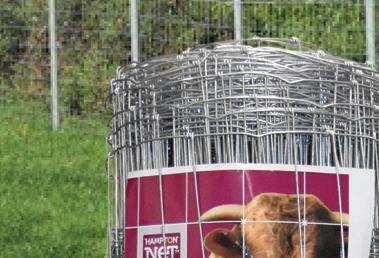




















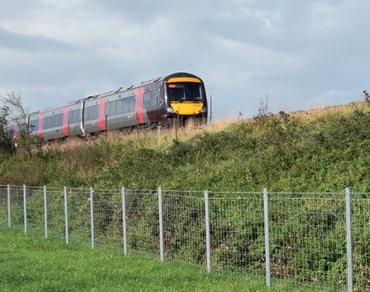
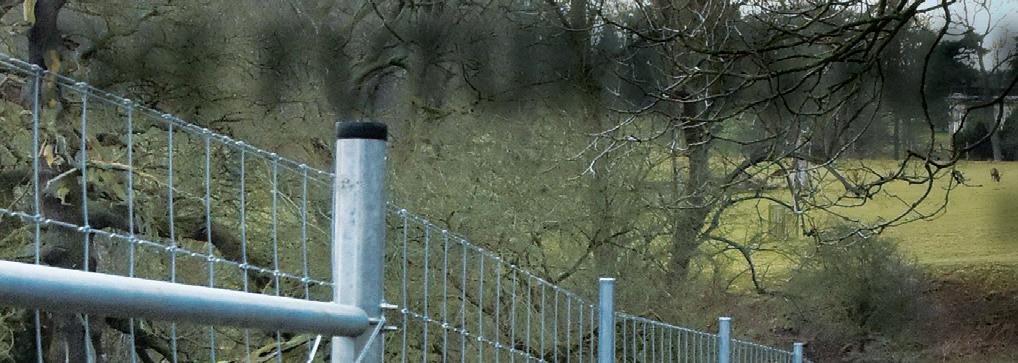



For a superior integrated solution to your fencing needs, combine the award-winning Versalok® intermediate metal post and clip system and Hampton’s Metal Strainers, all covered by Hampton Steel’s 30 year guarantee, with any woven wire fencing pattern. Choose from Class A galvanise Hampton Net™ fixed knot fencing or Sentinel® hinge joint supplied in rolls of up to 500 metres. Alternatively opt for our longer life green passivated Hampton Net™ Green, Rylock® Green or Rylock® One products. All these can be supplied with barbed wire, line wire and fencing staples in complementary coating options. Also available, chainlink fencing either class A galvanised or PVC coated with barbed or knuckled ends, fully galvanised hexagonal wire netting and Gripple® wire joining products. The future of wire fencing is Hampton Steel.



























Lead ammunition, long a staple of deer management practices, has in recent years been recognised as often causing more harm than good. Ed Bewsher of Edinburgh Rifles and Sporting Goods shares the other options available, and the progress being made to phase lead out.


The move away from lead ammunition for deer management has generated much discussion over the past few years. Efficacy, accuracy, availability, cost and whether some calibre/cartridge combinations will become obsolete have all been raised concerns.
Edinburgh Rifles is an independent Registered Firearms Dealer (RFD) in Scotland and has been working alongside a number of bullet and rifle manufacturers to develop lead-free solutions that solve some of the known issues with existing popular rifle calibre/cartridges and their use on UK deer species.
For ethical wildlife management, the primary concern is to achieve a quick humane kill on any animal or bird. Causing major damage to the heart, lungs and surrounding arteries leads to very rapid loss of blood pressure and supply of oxygenated blood to the brain and other vital organs. Causing major damage to the central nervous system (CNS) at the same time will result in an immediate loss of consciousness and thus the animal will fall on the spot.
With any animal or bird that enters the human food chain, it is important to minimise excessive damage and contamination to the carcass and to ensure the carcass is quickly recovered to the larder.
The “vital zone”, comprising of the heart, lungs, major arteries, and major bundles of nerves connecting the central nervous system, is located in the front third of an animal’s body, protected by the rib cage and shoulder bones and shoulder muscles. An appropriately designed rifle bullet (or in the case of birds, multiple shotgun pellets) passing through these vital organs will achieve a very quick kill.
On a small deer or fox, the vital zone is the size of a smaller smartphone; on a larger deer it will be nearer the size of an A4 piece of paper. With larger deer and wild boar, a bullet may also have to penetrate through several inches of skin, meat and bone before entering the vitals.

The traditional “cup and core” bullet was first designed in the late 1880s. A copper cup is swaged over a lead core, which is then squeezed through a series of dies to give an accurate shape and diameter.
Over the last century, there have been several different iterations to improve accuracy, ballistic and terminal performance, but the same basic design has remained. There are even “lead free” variations that replaces the lead core with less toxic tin or zinc.
The “monolithic” bullet is the industry standard for non-lead bullets. These are solid copper, or copper alloy, usually made on an automated lathe from bar stock. In the last decade, there have been a lot of advancements to make monolithic bullets work at all velocities and on all sizes of animals – particularly European deer species.

Fundamentally, there is no difference between cup and core and monolithic bullets in terms of accuracy and ballistic performance in normal deer stalking ranges. Both shoot well within accepted requirements and the effect of distance and wind out to 250-300m is minimal.

However, the Deer Act in Scotland and England & Wales prescribes minimum calibre/weight, and in some cases muzzle velocity and muzzle energy when choosing a bullet. The limits of some cartridges in the twist rates of the barrels makes it hard to conform to the Act when using non lead. Notably .22-250 50gr, .222 50gr, .243 100gr in standard twist rates.
These cartridges are very popular for small deer and the .243, being the minimum calibre for large species and often recommended as a first cartridge for Fire Arm Certificate applicants, is extremely popular. Until recently a 100gr non-lead option was not available, though now available in the Fox and Peregrine brands.
There are new bullet and ammunition brands entering the UK market from South Africa (Peregrine) and Eastern Europe (Fox Classic Hunter), alongside the more established US and European brands (Barnes, Hornady, Federal). Pictured above is a Fox .308 bullet before and after firing,
The variables involved in a bullet killing effectively are numerous, but the main cause of death is through blood loss, organ destruction and/or CNS disruption. Most hunting bullets are designed to expand on impact and change from being a sleek, pointed bullet into a wide, flat-headed projectile, two to three times the bullet diameter.
The projectile creates a large void in the body as it passes through, drawing in air and creating a pressure wave that significantly damages organs and the CNS. The effect of the shockwave on the major nerves in the spine and/or the shoulders, and at the junction of the heart and lungs will render immediate loss of consciousness.
It is on this impact we see the biggest differences in monolithic bullets compared to cup and core.
When a traditional bullet hits, the lead >>
core starts to peel back rapidly and the bullet mushrooms in shape. A significant proportion of the lead core will fragment or melt into a spray of lead particles that pass into the carcass causing wider damage. Imaging technologies have shown that bullet particles, many of which are microscopic, can travel up to 50cm from the point of impact.
These lead particles then remain within both the meat, which goes onto human consumption, and the gralloch (the internal organs), usually left in the field to be consumed by scavengers and predators. A bullet weighs between 6-12g and typically loses 50-70% of its weight as it passes through the carcass, leaving 4-9g of lead as very small, difficult to remove fragments.
Additionally, lead is a soft material and if a bullet hits a major foreleg bone or shoulder material with too much velocity, it can easily fragment completely within the shoulder muscle, ultimately failing to adequately penetrate the vital organs.

Many different types of cup and core bullets try to control the expansion, but they all leave lead fragments to a greater or lesser extent within the carcass.
Most monolithic bullets work very
Radiograph of a roe deer shot with a single unbonded lead rifle bullet, showing the extent of the bullet’s fragmentation and the distance of fragments’ spread from the entry site. Most of the small fragments would not likely be removed prior to butchering and retail sale, thereby exposing the consumer.
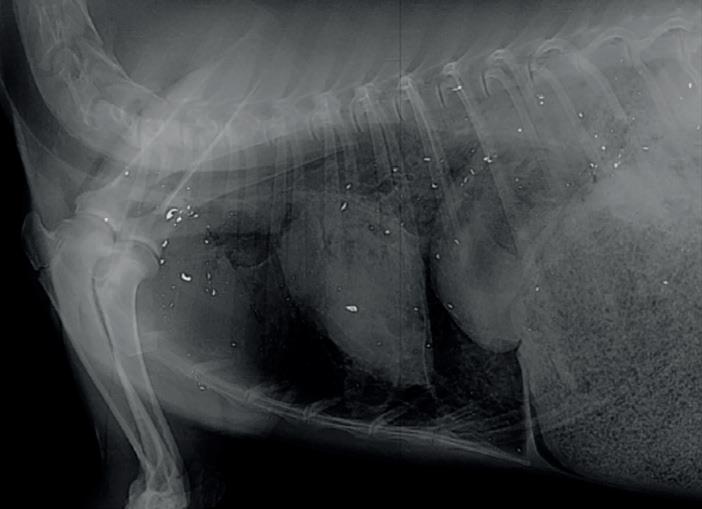
Photo credit: Oliver Krone, Leibniz Institute for Zoo and Wildlife Research, Berlin.
Point of entry: A typical roe deer cup and core wound (far left) and a monolithic bullet wound (left).

As noted by the World Health Organisation: “Lead is a cumulative toxicant that affects multiple body systems… There is no level of exposure to lead that is known to be without harmful effects.”
Lead is no longer used in paints, petrol, water pipes, solder or other products where there is potential for human interaction. Ammunition manufacturers are aware of these dangers and most ammunition packaging contains warnings about the dangers of lead, albeit often in small print.
differently. On impact, the nose of the bullet opens into a flat flower shape which spins at high rotational velocity.
Copper is far less malleable than lead, so the bullet remains intact as it passes through. Because the bullet doesn’t lose mass, it maintains velocity. As a result, the cavitation bubble and pressure survive for a much greater percentage of the wound tract, compared to a fragmenting bullet that is slowing down.
Recovered bullets are typically 95-99% of their initial mass. If any petals do break off, they are large enough to be seen by the naked eye or are big enough, with sufficient energy, to exit. The monolithic bullets leave a much cleaner carcass, with little bruising and minimal meat damage either side of the wound channel.
There has been a lot of debate regarding the efficacy of monolithic bullets and animal welfare considerations. Major deer management agencies have conducted their own research before adopting the new technologies.
A National Forest Agency conducted a study using Fox Classic ammunition in conjunction with Edinburgh Rifles. 500 rounds were used to cull deer through a six-month period across three species. For each deer, sex, species, range, shot placement and angle, awareness, reaction to shot, and distance run were all recorded.
There was no significant difference between shooting deer with traditional ammunition versus lead-free. In fact, the same data for some brands of lead bullets did not perform as well. However, the monolithic bullets resulted in significantly less damage to valuable meat.
Most ammunition brands are now loading monolithic copper bullets in a variety of loadings and calibres. Ammunition loaded with monolithic bullets is now available for the vast majority of deer stalking rifles in everyday use within the UK. For the common cartridges, there is a good choice of different brands and bullet weights and types to choose from.
The uptake of lead-free ammo by UK retailers is slower than it could be as product purchasing is not always lead by customer demand.
Venison and other game should be a valuable co-product from woodlands, forests and marginal land. It is treated by many restaurants and retailers as a premium product that is organic, sustainable, low in fat and healthy. Yet when a deer is shot with a lead bullet, or when game birds are killed with lead pellets, the meat is contaminated.
Such meat has to be treated as biological waste, it cannot be used in pet food, and the cost of disposal is a significant burden on food processors.
Ingesting lead can give rise to many health complications, from changes in behaviour to fatal poisoning. The real challenge is the cumulative effect over a lifetime and how even very low levels can have serious implications.
A US-based study in 2009 showed that pigs fed with contaminated lead-shot venison show a rapid rise in lead levels in the blood. Further studies of indigenous US hunters who survive principally on hunted meat shot with lead bullets have significantly elevated blood lead levels.
Further, a strong correlation between patients diagnosed with acute myeloid leukaemia (AML) and elevated levels of heavy metals, in particular lead and cadmium (albeit at levels far lower than normally considered toxic), has been shown in research at the MD Anderson Cancer Clinic in Texas.
In the wider environment, not all game birds or deer shot will be recovered. There have been numerous post-mortem studies on dead birds of prey that appear to have died from natural causes showing that the majority have significantly elevated levels of lead in their blood.
The only widespread source of such contamination is from carcass remains of lead shot animals and birds. These studies have been carried out in Europe, the US, and here in the UK.
• Edinburgh Rifles and Sporting Goods: https://bit.ly/3SjRIBT
• Setting maximum levels for lead in game meat in EC regulations (2020): https://bit.ly/3RA8jAB
• Lead poisoning (WHO): https://bit. ly/2tplBqS
• The impact of lead poisoning from ammunition sources on raptor populations in Europe (2022): https://bit.ly/3UOPvjR
www.heathwood.co.uk sales@heathwood.co.uk The Meadows, Higher Heath, Whitchurch, Shropshire SY13 2JA Tel 01948 840 120



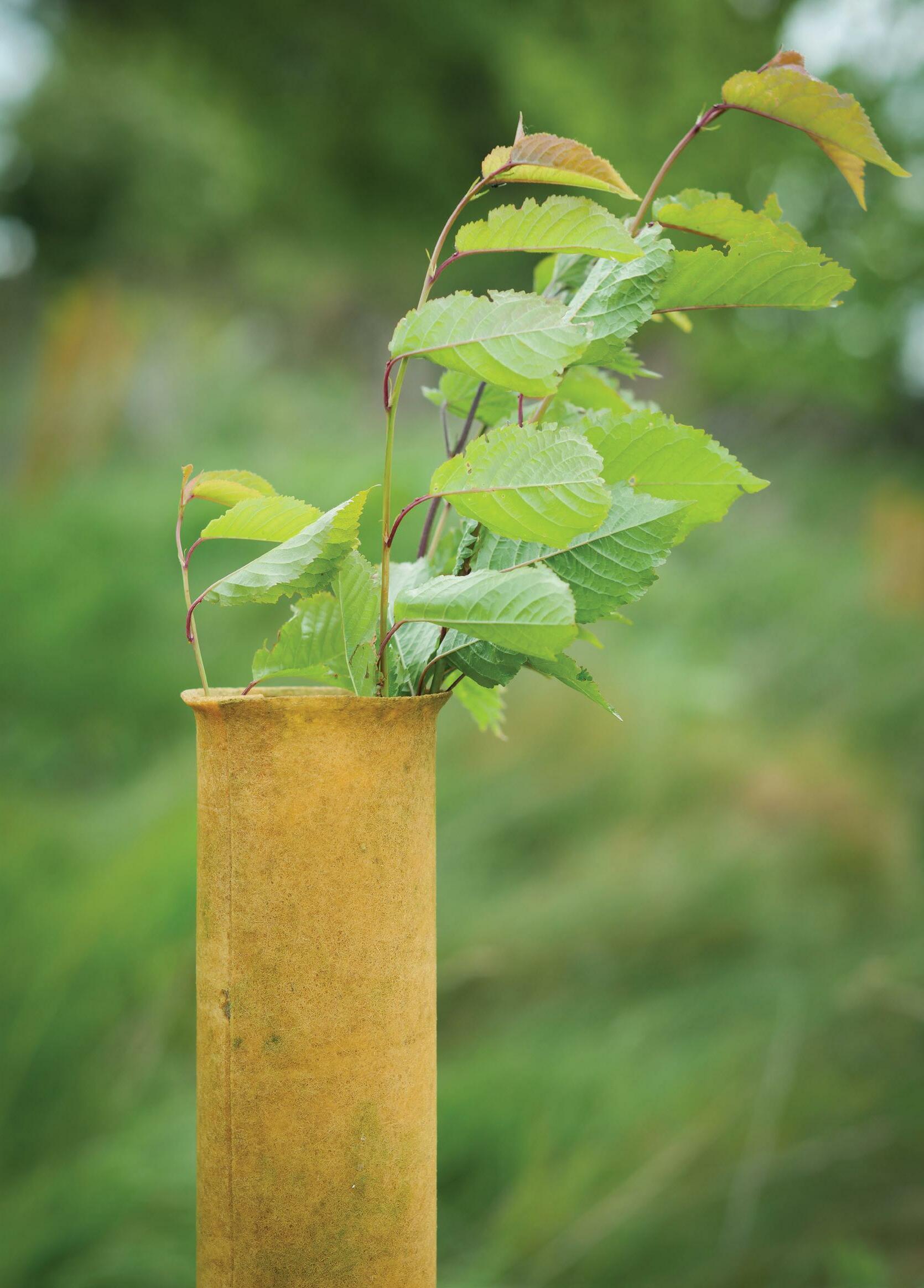


Societal concerns around climate change and decarbonization are driving what industry and policy makers are calling the Green Revolution, a movement in manufacturing from black petro-sourced carbon to green bio-sourced carbon, writes Miranda Lindsay-Fynn Commercial Director at Bio-Sep.
Carbon is the backbone of so many everyday materials and products that the chemical industry pro ducing these products accounts for around 6% of global petroleum use.
Global brands including Unilever, Pep siCo and L’Oreal are investing billions of pounds to remove fossil-derived ingredi ents from their products and packaging over the next 5-10 years, significantly in creasing demand for bio-derived alterna tives. However, with natural resource de pletion, increasing strain on global supply chains and an ever-growing global popu lation, there are significant sustainability concerns regarding the use of food crops in chemical production.
Focus instead is shifting towards the use of low value co-products from agricultural and forestry operations as a more suitable source of biochemicals.
Against this backdrop, Bio-Sep’s mis sion is to maximise the value of underuti lised resources. To achieve this, Bio-Sep have developed an award-winning low-en ergy ultrasonic process to convert woody biomass into chemicals. The Bio-Sep pro cess generates almost zero waste, is wateruse neutral, and produces three high-value products: cellulose, sugar syrup and lignin.
The fibrous or woody component of plants and trees is called lignocellulose. The word derives from ‘Lignum’, the Latin name for wood, and is essentially nature’s compos ite. Wood consists of three components: cellulose fibres together with hemicellulose form a matrix, which in turn is bound to
gether by an aromatic biochemical called lignin.
In nature, this complex chemical struc ture of three biochemicals results in a solid cell wall that is resistant to wind, water, pests, and sunlight. When separated from each other, these biochemicals are known as bio-based platform biochemicals and have wide market potential.
For many years, cellulose has been ex tracted from wood for the pulp and paper industry. Bio-Sep’s ultrasonic process pro duces a crystalline cellulose which is a high value speciality chemical with applications
The UK’s composite challenge is an opportunity
Humans have been making composite materials for years, starting thousands of years ago with bricks made from mud
new, resulting in truly circular green materials.



With colder temperatures drawing in, firewood suppliers may be looking to , Forestry Lecturer
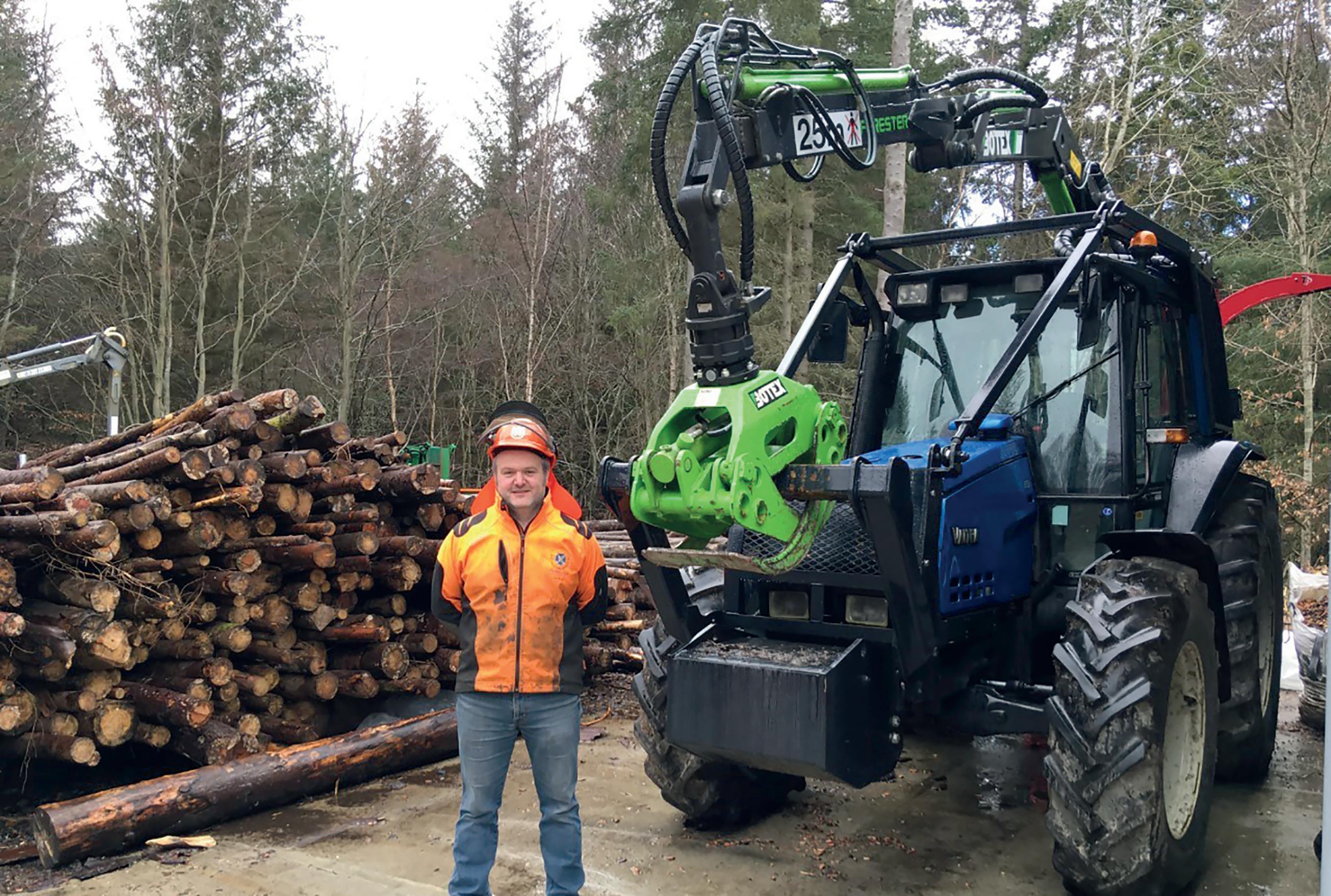
The three models in the circular saw range feature maximum crosscutting capacities from 30-40cm with splitting forces ranging from 6 tonnes to 16 tonnes on the largest capacity C1000. The C1000 utilises a 1,000mm diameter sawblade to achieve its maximum crosscutting potential. Product length can vary between 25-55cm, and a variety of splitting wedges
know who new Prime Minister of the UK is – Liz Truss. One of the priorities she has set out is to tackle the cost of living and energy crisis. I suspect most of us will have been involved in conversations recently about rising energy bills, be that for vehicle fuel, electricity, or household fuel bills.
As I recently heard about a quite astonishing increase in electricity costs for a local timber processor, it is not an issue limited to the home, either.
Many are now starting to give log burners serious consideration, mainly with an eye to reducing heating costs and not being reliant upon them as either their sole source of heat or for heating water.
A high number of my friends and colleagues have a log burner installed, be it
here.
For those who are in the firewood business and didn’t empty their wallets at APF, it may well be time to think about upgrading your equipment to meet demand.
This is not an exhaustive list, and there are several other well-known brands out there, but these are some of the offerings available from the sector’s machinery manufacturers.
Palax offer a range of firewood processors with either a circular saw or chainsaw method of crosscutting. Both have their benefits and downsides, and both have their fans!

On the chainsaw side of the range, capacities range from 360mm on the KS360 up to 450mm on the KS45St, and splitting forces of up to 18 tonnes on the largest KS45S model. The 450mm crosscutting capacity on this model is achieved by using a 20 inch (500mm) saw bar. Again, a variety of splitting wedges are available.
The Palax range of processors are available with several power method options – PTO, electric or both. The Palax range is supported by a range of equipment which helps to make the task easier, cleaner and produce a better product. These include a selection of log decks, sawdust extraction equipment, and log cleaners to remove the detritus sometimes created during processing.
The Posch range of equipment is wellknown and well-proven in the UK. Though we maybe typically think of firewood continued on p61

















































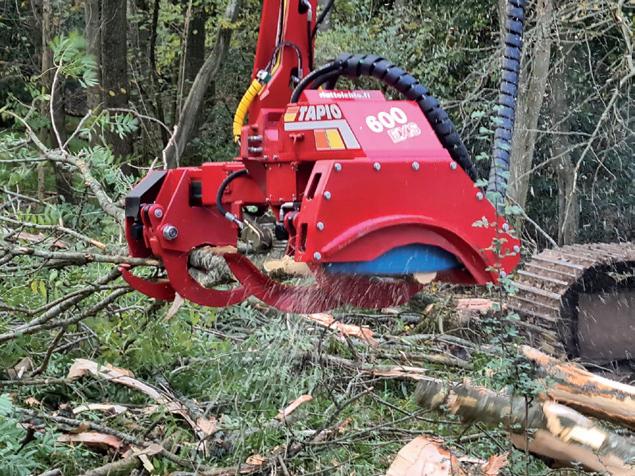





from p58
equipment as coming from Nordic countries, this Austrian manufacturer has gained a bit of a cult following in the UK.

The range again consists of both circular saw and chainsaw models, with the highest crosscutting diameters being achieved by the chainsaw models. Capacities range from 375mm up to 700mm. In particular, the Spaltfix S-375 and 415 models have proven to be very popular in the UK.

The 415 is available as either a S model (circular saw) or K model (chainsaw). Towable variants are available on both models, making them suitable for processing at a variety of locations –perhaps contract processing is in your remit!
Moving up the scale are the K540 and K650 models. These are large mobile processors with crosscutting capacity up to 650mm. The splitting mechanism on these models is similar to that found on the Posch Kindling machines, and continuously cycles as logs move along the conveyor rather than the conventional splitting system we associate with processors.
Lastly, the K-700 Vario and 710a Vario are serious producers. These machines are designed for high output. Whilst they are available as stationary or static machines, the initial units are set up as static units in large sheds. They are, in reality, selfcontained firewood factories and will need
Along with decks, dust extractors and log cleaners, the Posch range of equipment consists of a variety of other equipment such as splitters, circular saws and packaging equipment. A real one stop shop, with a method of processing virtually any piece of timber!
The Finnish manufacturer produces a range of six firewood processors, from the Raven 33 with 330mm crosscutting and 6 tonnes of splitting force, up to the Pro 55 with 550mm crosscutting capacity and up to an incredible 40 tonnes of splitting force.


Coincidentally, increasing capacity also comes with more refined operating methods.
In between these two models we have the Falcon 35; the Pro 38; Pro 43; and 50 Pro. Crosscutting capacities are 350mm; 380mm; 430mm; and 500mm respectively with splitting force ranging between 8-30 tonnes Power sources are PTO, electric and combination.

Unlike other manufacturers, Hakki Pilke
Though Fuelwood are agents for the Japa range of firewood equipment (not covered in this article), they also manufacture their own firewood processor: the Fuelwood Factory.
The Fuelwood Factory is a customisable machine and is built around the Woodcutta 400 chainsaw crosscutting system, before the log is transferred to the splitting sys tem. The splitter can be either a Kindlet Pro; a Splitta 360 or a Splitta 400 to suit the end user.
When using the Kindlet Pro, maximum capacity is 200mm. That can go up to 460mm when equipped with the Splitta 400. Power for the factory is by means of 3-phase electric.
The machine features several novel fea tures, such as ejecting the last short piece of timber so that all the product is a con sistent length – of particular use to those who bag their firewood. As usual, items such as decks, dust extraction and bagging equipment are also available to suit.


The Timber Transport Forum has commissioned a study to examine the potential for installing alternative-to-diesel infrastructure in remote, rural parts of Scotland, writes Paul Boobyer
Targets to decarbonise road freight to avoid the need for new diesel HGVs by 2040 were announced by the UK Government earlier this year. Scotland is shooting for a target of 2035.
The current annual timber harvest from Scottish land is around 7m tonnes, mostly moving on 44-tonne lorries on public roads, all of which will need to be transported by net zero vehicles within the next 13 years. New infrastructure installations such as EV charging and hydrogen fuelling points will be a requirement to achieve this.
In order to explore the hurdles and opportunities to decarbonising the road freight industry, Transport Scotland has established a Zero Emission Truck Taskforce, chaired by Scotland’s Transport Minister and comprising leaders across manufacturing, energy, finance, and road haulage and logistics to identify the necessary measures and milestones to achieve zero emission trucks.
The Taskforce met for the first time in May 2022 and has since discussed net zero trials, data and the supply chain, and infrastructure. In October it will focus on financial models.
Zero emission truck technologies are developing rapidly. The developments have mostly been in EV technology to date, and some are now market-ready, but hydrogen trucks and EV/hydrogen hybrids are currently being trialled in various countries.
However, real-world data is not yet available for operators to assess which vehicle type they might buy when replacing diesel vehicles in their fleets, and there is very little information on where these vehicles might be charged or fuelled during their duty cycles.
For the transition to net zero trucks to take place, charging or refuelling infrastructure will be required either in a depot or at appropriate points enroute. It is likely that in many cases, both will be necessary.

The initial focus for infrastructure across Britain is inevitably on the main freight routes – the motorways and major trunk roads. It will be necessary to ensure there is sufficient recharging and refuelling provisions in place to serve rural freight.
Given the UK and Scottish Governments’ commitment to phase out diesel-powered continued on p63











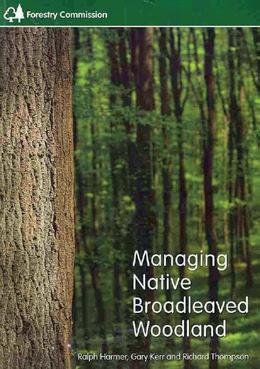
















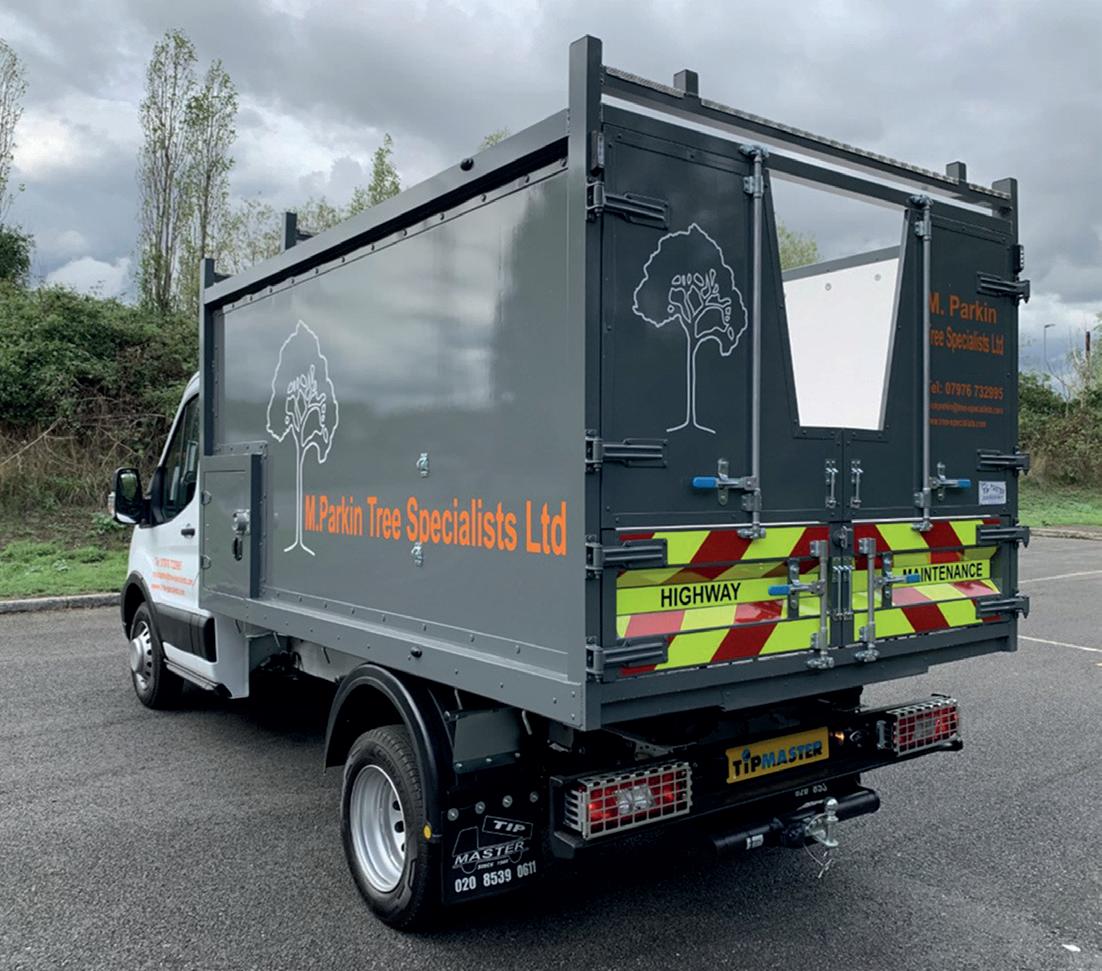




The Zero Emission Truck Taskforce is encouraging trials that focus on net zero infrastructure, and the Timber Transport Forum (TTF) has consequently initiated a pilot study that aims to provide data on where this infrastructure might be located along key timber transport routes in rural Scotland.
The study will be carried out by GeTech, which has decades of experience and a broad range of capabilities in GIS analysis and location-based energy modelling. They have offices in Leeds, London, Edinburgh and Houston, and have undertaken a detailed analysis of the UK freight rail network to identify and rank potential locations for hydrogen production and storage/refuelling facilities. Additional analysis will pinpoint potential hydrogen storage sites in Scotland, based on multiple criteria that are very similar to the TTF project.
The locus of the project being done for the TTF will be the Argyll and Borders timber transport group regions. A pilot study of these two regions should provide information that can be extrapolated to other regions.
The scope includes:
• Exploration of the energy demand for timber haulage over the period to 2045, and its spatial distribution over the pilot area.
• Quantification of the demand needing to be serviced by new refuelling/recharging infrastructure.
• Identification of suitable locations/ opportunities for refuelling/recharging infrastructure.
To complete this work, GeTech will focus on four key tasks:
1. Data gathering and processing.
2. Creating heat maps using GIS of timber haulage routes to determine which are most heavily used.
3. Estimating current charging and fuelling infrastructure requirements (based on historical/existing data).
haulage routes.
• Details of the power output required per refuelling/recharging location.
• Space requirements and charging/ refuelling time required for the locations.
These outputs will be achieved using data from the National Forestry Inventory’s 25-year projections of timber availability, the Forum’s exit point data, the TTF’s GIS data of timber processors and ports where timber is exported, data from the Forum’s Agreed Routes Map, and GIS data of the locations of timber hauliers.
A road haulage decarbonisation overview report produced for the TTF by Creel Consulting earlier this year, which can be viewed on the Decarbonising Timber Transport page of the TTF’s website, discussed in detail the barriers and opportunities of transitioning the timber haulage by road to net zero.
The study being carried out by GeTech will provide further information to our sec tor and will inform other road freight sec tors that will probably use the charging and hydrogen refuelling infrastructure. Installing this infrastructure is a huge task but this study will assist in one small step of that process.

“LOCATIONS OF EV CHARGING AND HYDROGEN REFUELLING INFRASTRUCTURE WILL NEED TO BE CONSIDERED IN THE CONTEXT OF THE GEOGRAPHICAL CHALLENGES POSED BY TRANSPORTING TIMBER IN REMOTE LOCATIONS.”
Over one million hectares of forest in Scotland have been surveyed for pests and diseases by the body’s tree health team in 2022
As part of Scottish Forestry’s efforts to monitor the health of wood lands in Scotland, tree health ex perts have reportedly surveyed over one million hectares of forest this year.
In addition to keeping alert for a range of other tree pests and diseases, the agen cy has been particularly monitoring larch trees for signs of Phytophthora ramorum.
This disease was first found in Scotland in 2002 on a range of species in horticul tural settings. Since 2009, it has increas ingly affected forests containing larch in the south and west of Scotland, where the wetter and warmer climate is known to be favourable for the disease.
As a result of the actions set out in the current P. ramorum Action Plan, the dis ease appears to be under control across
most of Scotland.
James Nott, Head of Tree Health for Scottish Forestry, said: “With over two thirds (over 40,000 hectares) of Scot land’s larch resource still unaffected by P. ramorum, management efforts will con tinue to be concentrated in the Priority Action Zone (PAZ) of eastern and north ern Scotland. Surveys in these areas have demonstrated clearly that swift felling of affected trees is an effective and realistic control method.”
As reported in the previous issue of Forestry & Timber News, Scottish Forestry announced plans earlier this year to fell all larch trees on their land in southwest Scotland in an attempt to manage the spread of the disease.

“In the areas of the south and west of Scotland, where the disease has been established for a number of years, forest managers are taking a more strategic ap proach to managing the disease, and are encouraged to use proactive manage ment through the forest plan process,” continued James. “The efforts across the sector in tackling this disease is a credit to the range of professionals involved.”
The main surveillance programme is run by Scottish Forestry with the support of Forestry and Land Scotland and For
est Research. However, citizen science is also proving to be very useful with nearly a quarter of the survey sites in the Prior ity Action Zone being reported to Scot tish Forestry by foresters and interested members of the public. This continues the trend of increasing numbers of reports from previous years.
Across Scotland, a total of 613 larch sites have so far been identified for field survey in 2022, with 67 reports from forest owners and managers.
After review by a group of stakehold ers and scientific advisers, including rep resentatives from Confor, Forest Research, Forestry & Land Scotland and Scotland’s Chief Plant Health Officer, the current con trols set out in 2020/2021 will remain un changed.
James added: “We can all do our bit to help stop pests and diseases spreading, whether you are a forester or a member of the public. Tree diseases can be spread on machinery, vehicles, clothing, bike tyres and even on dogs paws, so every one should Keep it Clean before visiting a forest.”
Christie-Elite, one of the best-known UK growers of commercial tree species, has been offered for sale.
Specialising in broadleaf varieties as well as conifers for timber production, the Moraybased business is the only nursery in the UK producing both bare-root and cell-grown saplings. It is also one of the only nurseries in the world growing native Scottish montane species.

Tom Stewart of Galbraith, who is handling the sale, said: “Christie-Elite is renowned for the quality of its trees and has an outstand ing reputation based on over 200 years of experience.
“For sale as a going concern, this is a rare opportunity to acquire a successful business in the flourishing forestry sector. Timber is in huge demand globally and in the UK we currently import 80% of our timber, so there
More information, including the updat ed map on disease spread and a link to the larch action plan can be found on the Scottish Forestry website. is enormous potential to meet domestic and international demand.
“Christie-Elite has a significant range of bespoke buildings, plant and machinery in addition to the landholding, which is highly productive. The purchasers could potentially further develop the business, subject to the necessary planning consents.”
Established in 1819, the business produc es and ships millions of finished trees each winter to clients across Scotland, the UK and Europe for forestry, woodland and hedging.
The nursery holds significant built as sets on site, including a range of heated and equipped polytunnels and stores used in connection with the growing and storage of the tree crop.
The landholding extends to about 53.3 acres of freehold land and about 109 acres leasehold.

Small woodland owners have much to be thankful for, as indeed do all of us do in the forestry sector: one such is the investment of time and effort by past generations to create the arboreta, botanic and forest gardens we enjoy today.
In Britain, we are blessed by more such tree collections for our size than any other country. Mitchell’s Field Guide to Trees of Britain and Northern Europe lists well over 100 in the British Isles that are open to the public.
These thoughts have been prompted by visiting The National Pinetum at Bedgebury in Kent. It is one of the crown jewels of the Forestry Commission, if less wellknown than Westonbirt. This world-class collection has more species and varieties (taxa) of conifers than anywhere else – and by that I mean more than anywhere else in the world!
In three years’ time, it celebrates its centenary from when Royal Botanic Gardens Kew and the Forestry Commission began the collection in 1925, deliberately located on infertile, very acidic soils far from the fog and smog of London. It is now entirely under FC (Forestry England) auspices.
As with all tree collections it allows us to see what grows well and what doesn’t. For generations this has been the first stage in screening potential species, which has been so helpful to British silviculture with our impoverished stock of native trees, not least of conifers with just Scots pine, yew and juniper naturally occurring within our shores.
I won’t need to remind readers that Sitka spruce and Douglas fir come from North America, or that many species now being considered for the future owing to climate change come from the Caucasus, from Japan, from Chile, or from the mountains that ‘encircle’ much of the Mediterranean basin. You can see these conifers growing at Bedgebury.
For the small woodland owner, wondering perhaps what to plant on half an acre, visiting an arboretum or a wellfurnished National Trust garden might seem OTT. Even if the sheer joy of being among great trees is not reason enough, ideas and possibilities will come aplenty. Of course, tree nurseries may not have the exact species you would like to try but starting the journey of diversifying can only be for the good.
So do visit one of our country’s great tree collections!
At Bedgebury, the second stage of species evaluation also featured strongly in the past – the forest plots. Onetenth hectare plots of many of the more promising species were established and mensurational data collected. By the 1970s there were over 130 with 107 species represented.
Sadly, the great storm of 1987 wrecked many and this year’s Storm Eunice a number more, but this just highlights the point. Our long-time scales, our changing climate is making silviculture more fickle, less predictable and underscores the need for greater variety to hedge bets. Add to this mix new pest and diseases – and
the fabulous Bedgebury Pinetum is far from immune – then we must keep trying new species to help us grow productive woodland in the future.
I’ve kept the best ‘til last! If you visit Bedgebury you will find specimens of some conifers now extinct or nearly so in their native habitat. This great tree collection is helping us meet our international obligations in conservation of endangered species both now and, it is to be hoped, far into the future.
Sorry if this all sounds a bit like an advertorial – I guess it is because the National Pinetum is truly one of our great treasures.

Visits to great gardens hold the key to silvicultural inspiration
sources to help landowners plant in smaller parcels, whether that’s community or chards, shelter belts for farmers or getting diverse forestry projects off the ground.
“If you have land and are interested, please get in touch and we will work with you to develop your planting proposal.”
The Great Northumberland Forest has received £725,000 to support the planning and planting of more trees across the county.
The funding, which comes from the Government’s Nature for Climate Fund, will help landowners in Northumberland create well-designed and more diverse woodlands by combining trees and shrubs with crop and livestock farming - whatever shape and size.
This additional support will allow The Great Northumberland Forest team to im prove what is possible from existing funds and help landowners plant in in smaller are as which would not normally qualify for the Forestry Commission’s English Woodland Creation Offer fund.
More trees will help mitigate flood risk in vulnerable areas of the county and provide more places for nature and biodiversity to thrive. Also, as trees are fantastic carbon absorbers, this will also help Northumber land County Council towards its carbon neutral targets.
Mark Child, Programme Director for the Great Northumberland Forest, commented: “This is fantastic news. For the first time, we can help the landowners who want to plant at all scales.
“We will continue to help on the larger scale projects, but we now have the re
The fund works in two parts and follows Defra and Forestry Commission’s princi ples to ensure new planting is in harmony
The first part specifically supports the planting of trees, and the second part sup ports the surveying, consultation and de sign work needed when planning a small
Council leader Glen Sanderson added: “It’s great to see this kind of investment coming into our county. If done with care, combining trees in farming landscapes can

“Being a farmer myself, I get to see firsthand the benefits that trees bring to our lands and our country as a whole – from enriching soils, giving shade to livestock to creating beautiful green spaces and of course, improving our air quality.”
Each application considers how plant ing can enrich existing ecosystems which is vital as Northumberland hosts species and habitats which are struggling, such as the red squirrel, curlew, and peatlands.
Foresight Sustainable Forestry, an LSE-list ed company which invests in new and ex isting forestry, has entered a multi-millionpound deal with Virgin Money to support sustainable forestry and carbon reduction measures.
Virgin Money has provided a committed Revolving Credit Facility (RCF) of £30 mil lion and an uncommitted accordion facility of up to an additional £30 million as part of its Environmental Social and Governance (ESG) strategy.
This latest deal with Foresight furthers the bank’s reputation and commitment to carbon reduction lending.
Keith Wilson, Head of Energy & Environ ment at Virgin Money, said: “This transac tion represents an important milestone in the development of our business. With an established energy lending product offer ing and an ambitious ESG strategy, we are

increasingly focussed on growth through diversification.
“Sustainable forestry has the potential to make a significant contribution to Net Zero and I am extremely pleased we have been bold and made an early move into this market.”
Richard Kelly (pictured) Rob Guest, Co-Heads of Foresight Sustainable Forestry, added: “We are delighted that the RCF funding can be deployed into our exciting pipeline of forestry and afforesta tion assets, further enhancing the growing impact of Foresight and the con tribution we are able to make in the twin fights against climate change and biodiver sity loss.”
The RCF has a three-year tenor and two one-year extension options. It will enable new investments to be made with certainty of funding and on a timely basis, reducing performance drag associated with holding
The interest margin chargeable on the RCF is linked to certain Sustain ability and ESG targets, including a year-on-year increase in the total number of hectares of land acquired for carbon sequestering activities, and an annual rise in participants in Fore sight’s Forestry Skills Training Programme.
Performance against these targets will be meas ured annually, with the in terest cost of the RCF be ing amended accordingly in the following year.
A portion of the Government’s Nature for Climate Fund has been allocated to enrich Northumberland woodland.








Forestry England’s Craig Harrison won the coveted Beacon Bowl at the 2022 Foresters Golf Day, held on 29 September at the Whiteleaf Golf Club. Please contact John Clegg at Tustins Group Ltd (johnclegg@ tustins.co.uk) for information on next year’s event.


The winning team (left to right): Iwan Parry (Tilhill), Craig Harrison (Forestry England) and Dougal Driver (Grown in Britain).
Forestry in Pictures is a regular feature in FTN. For every issue, we select the most impacting photograph sent by a reader. If you have a photo you would like to see published here, please send your file to ftn@ confor.org.uk. Please include your name, a short comment text to go with the picture, and an image credit.
Photos should relate to forestry and timber and be of high-quality (minimum resolution 300dpi). Exceptional pictures might be considered for the front cover of a future FTN issue.
By submitting a picture to Forestry in Pictures you give Confor permission to use the file for noncommercial purposes in Forestry and Timber News or the Confor website. Photos will always be credited.
Remember that FTN is your magazine – get in touch if you want to suggest editorial or give us feedback on articles we have published in the past. Confor members, send us your company’s news updates or pitches for feature articles. Note that our general editorial deadline for the December FTN is 10 November 2022. If you would like to pitch an article idea, please do so by the end of October 2022.









